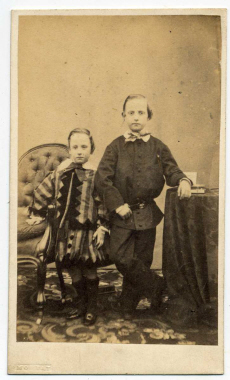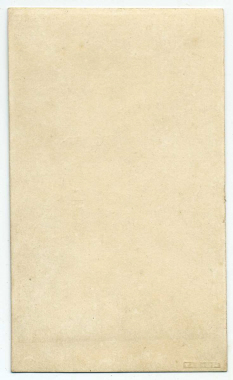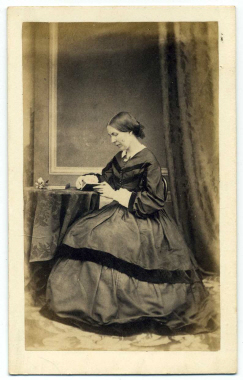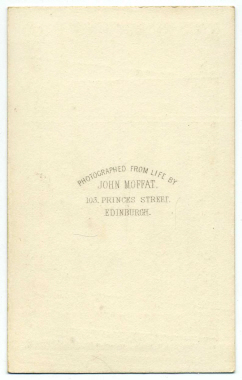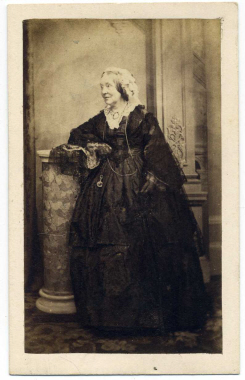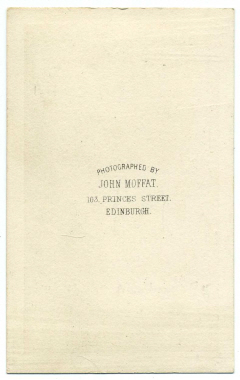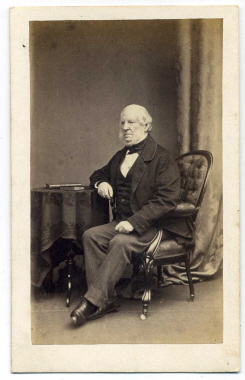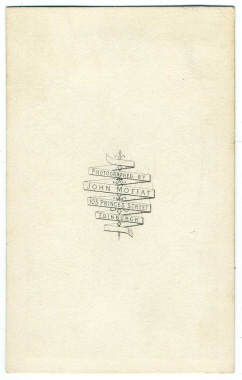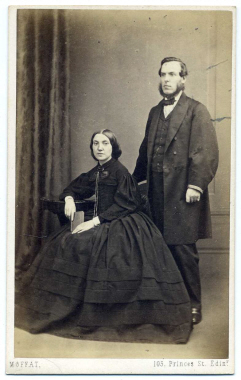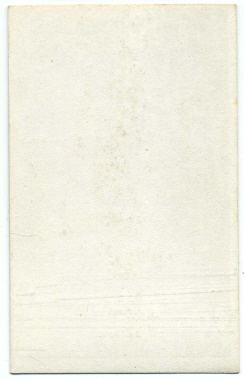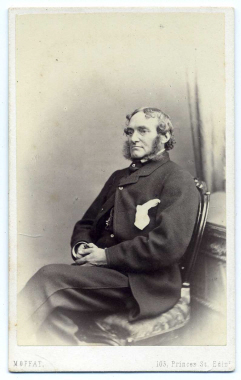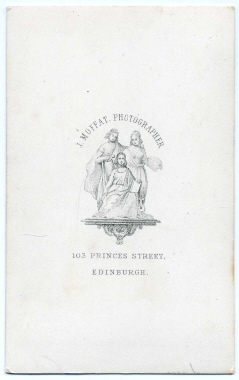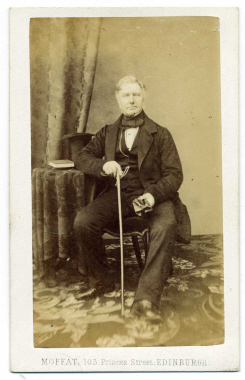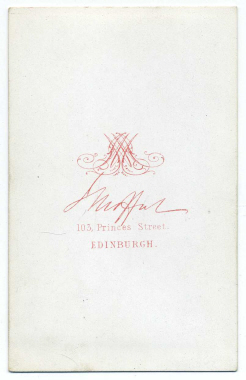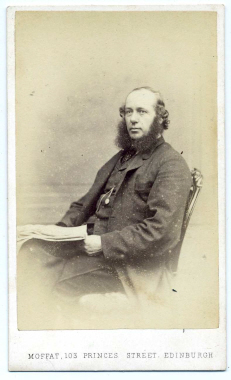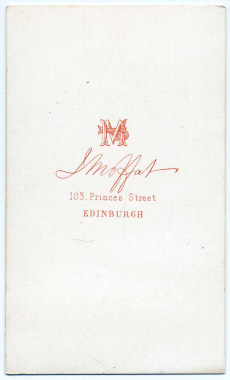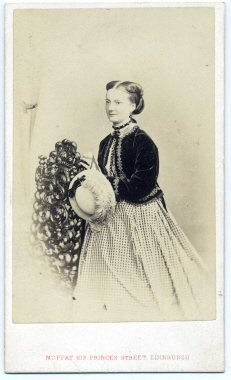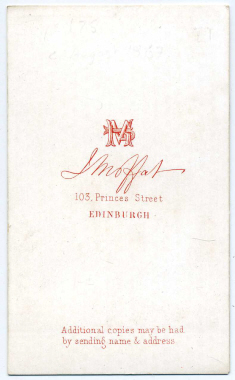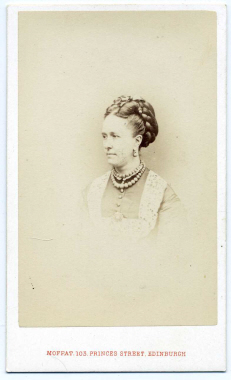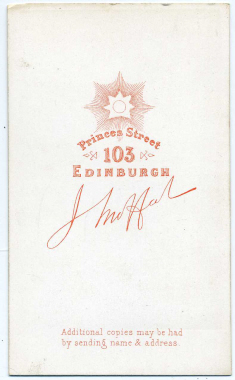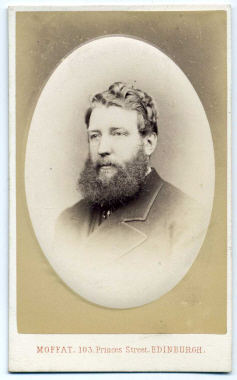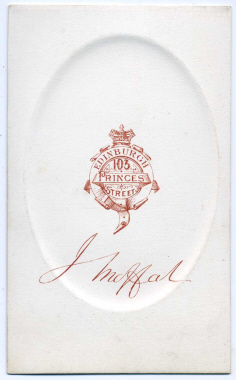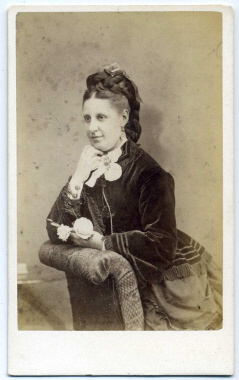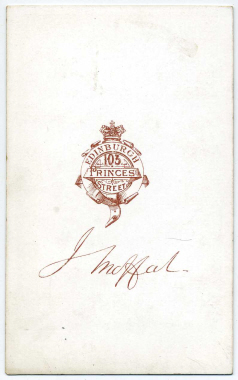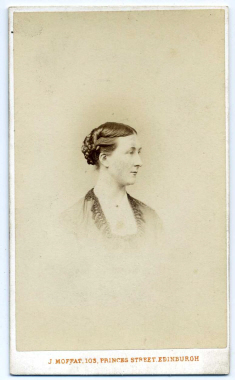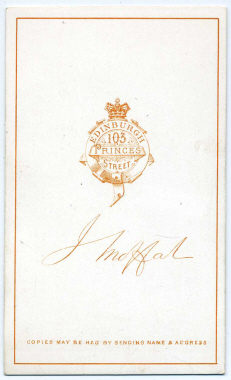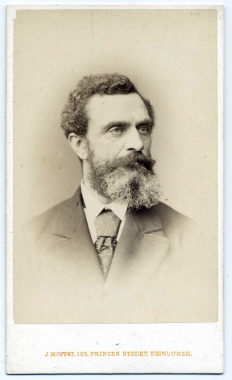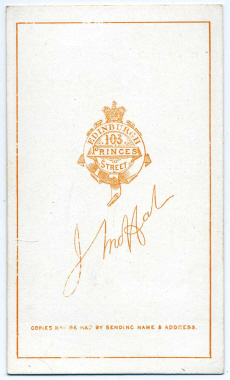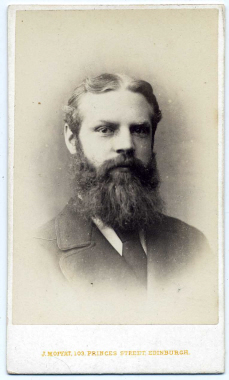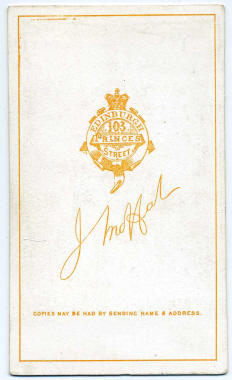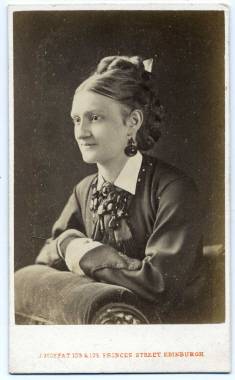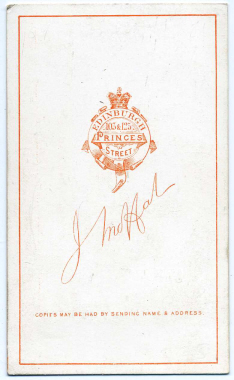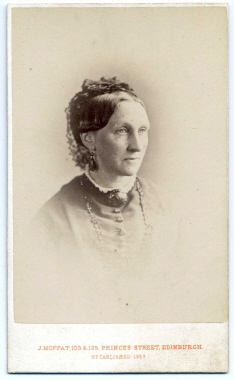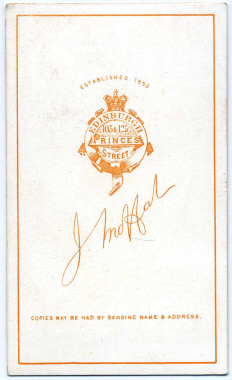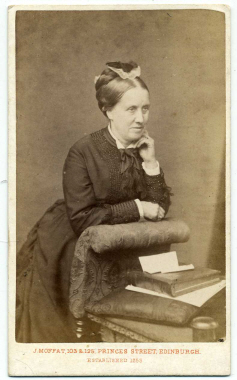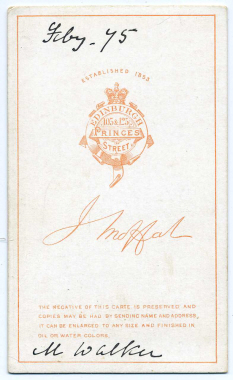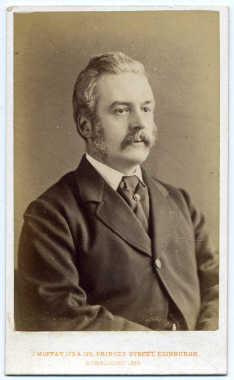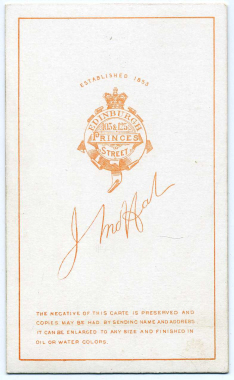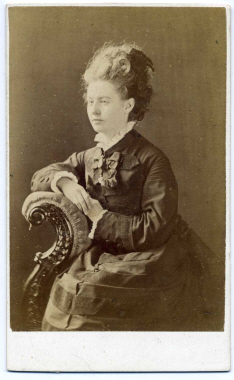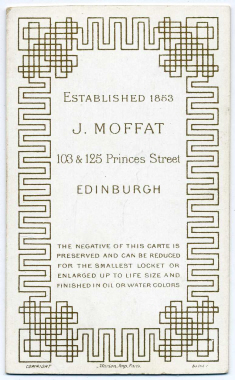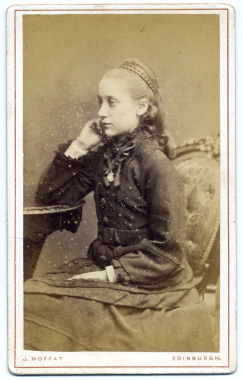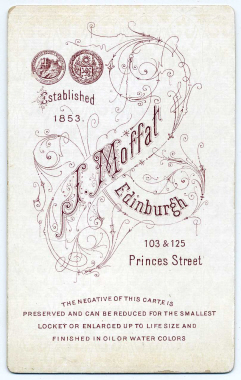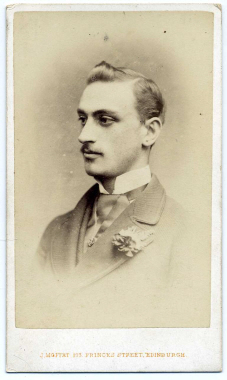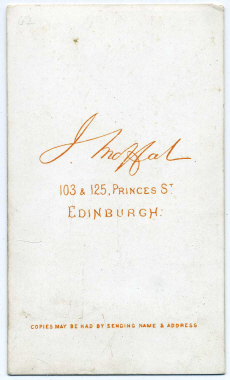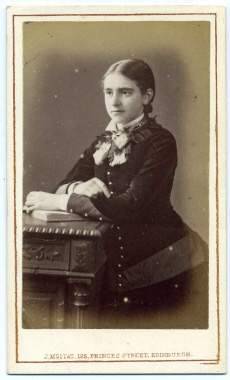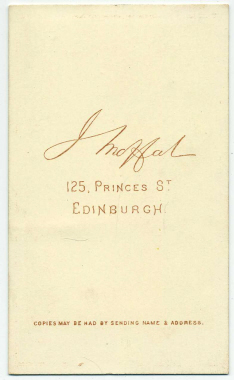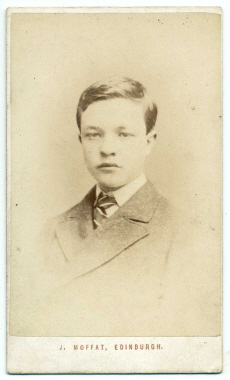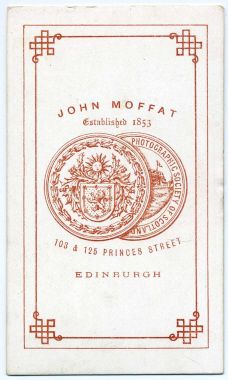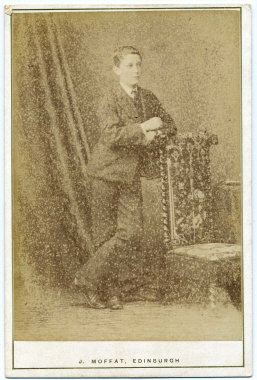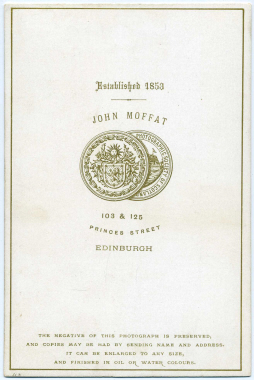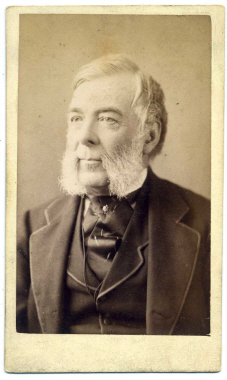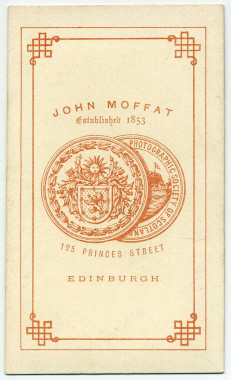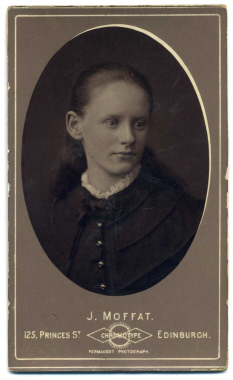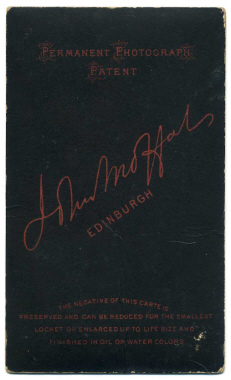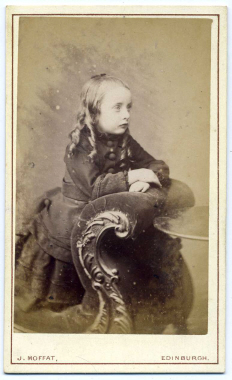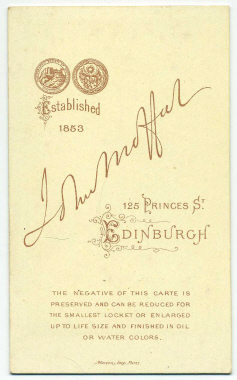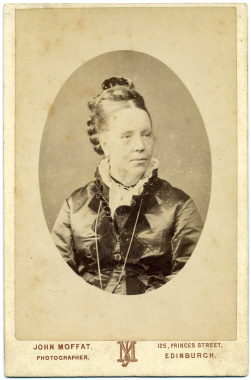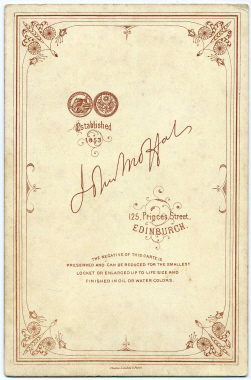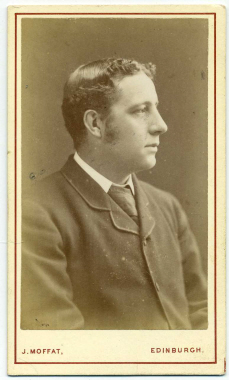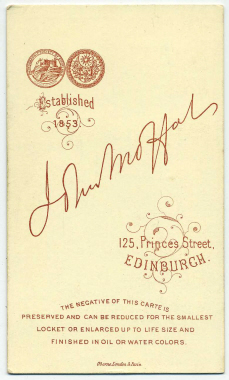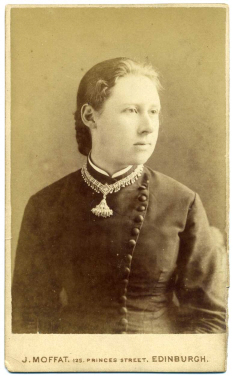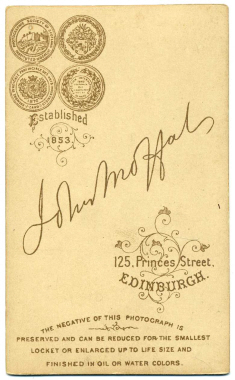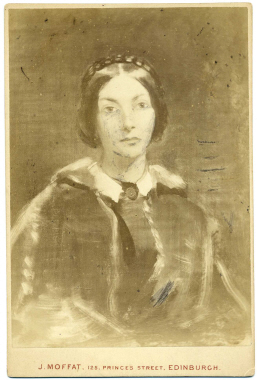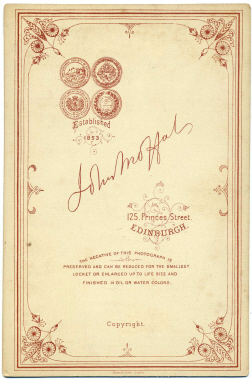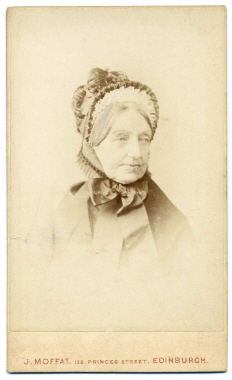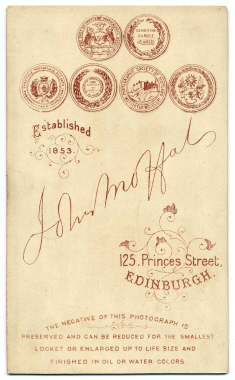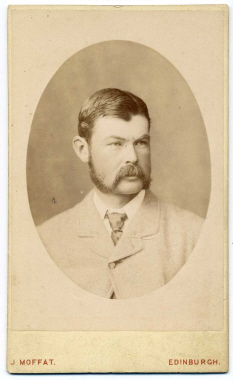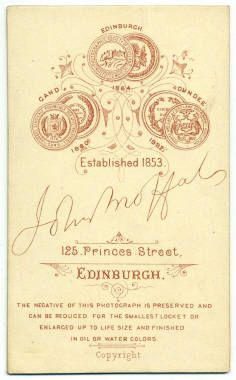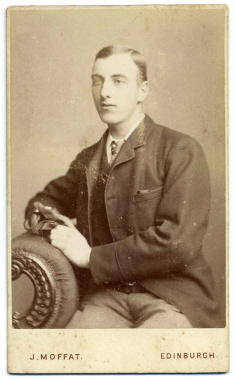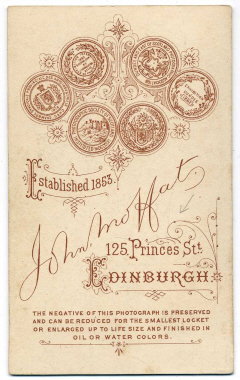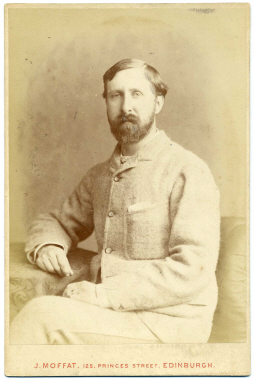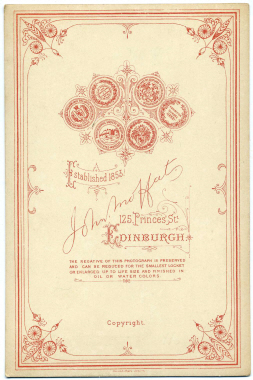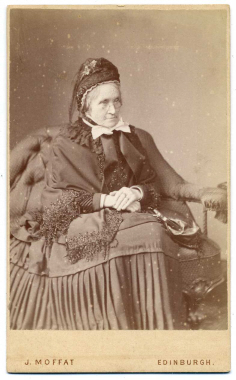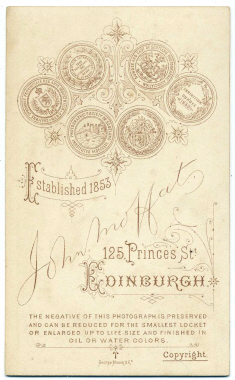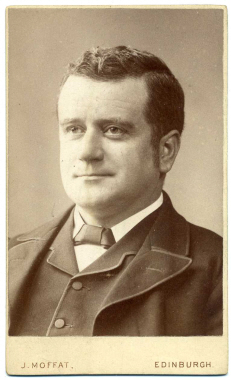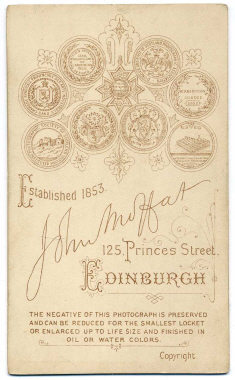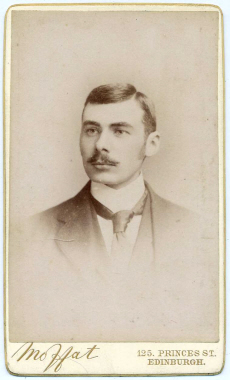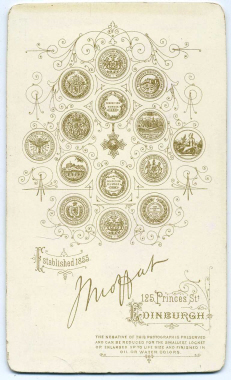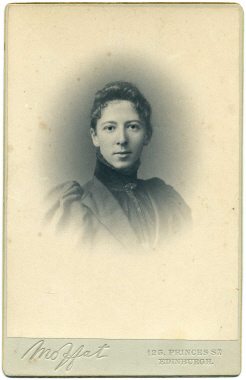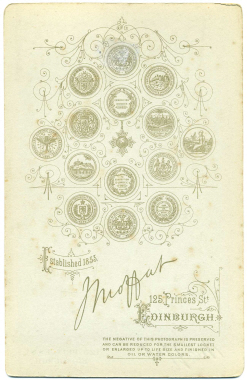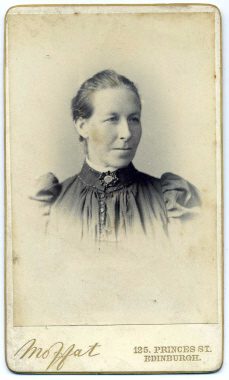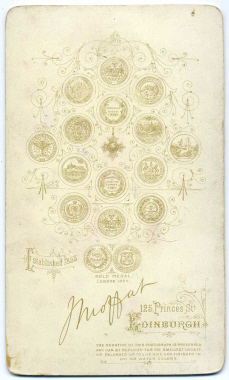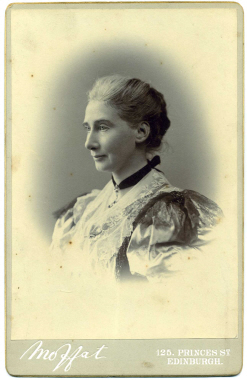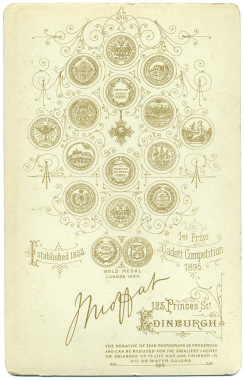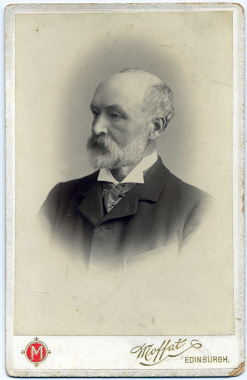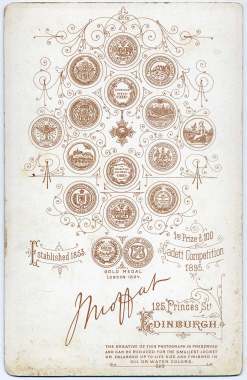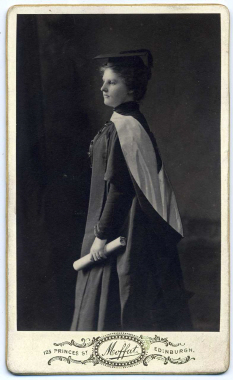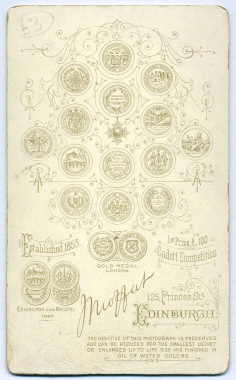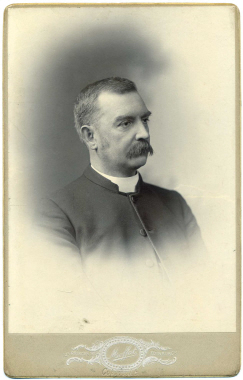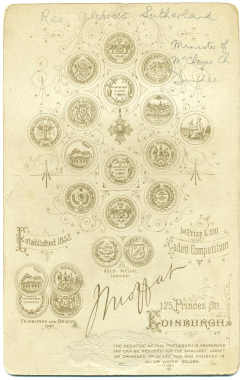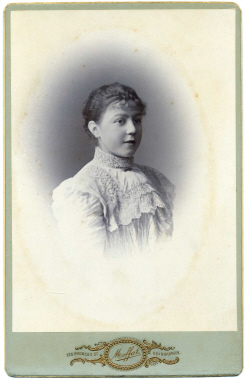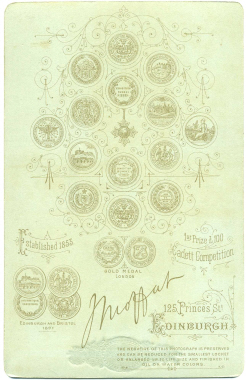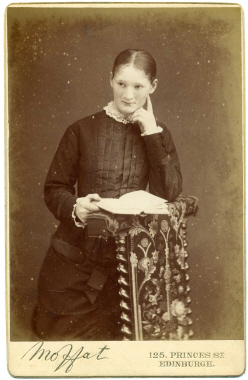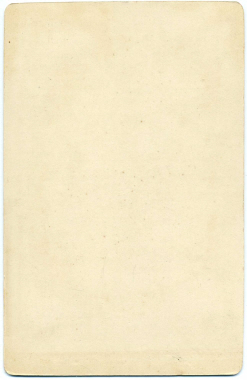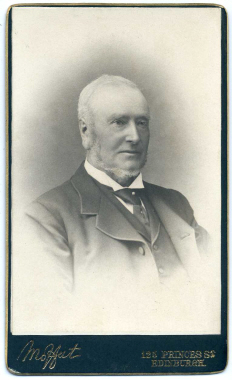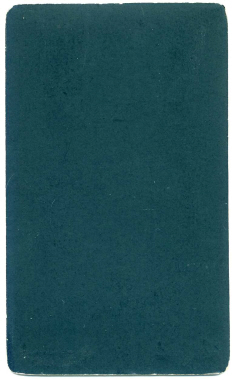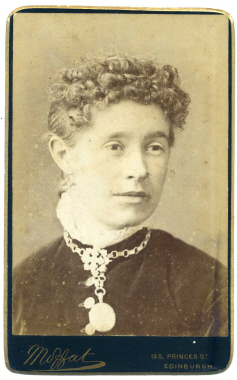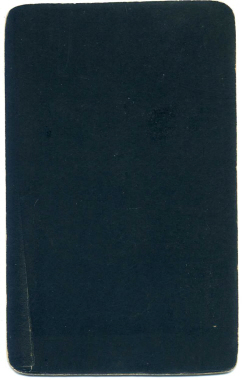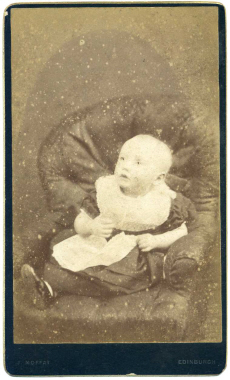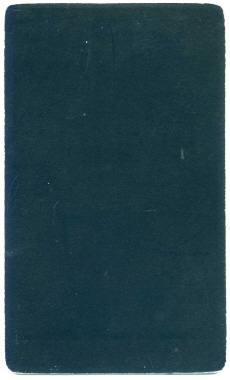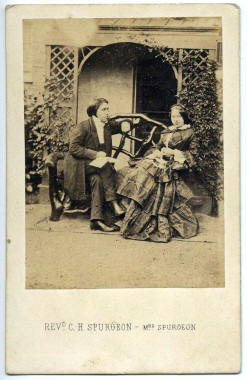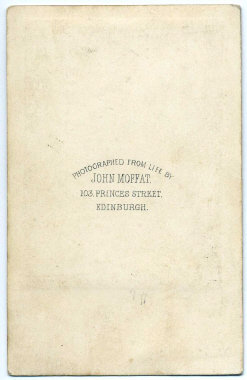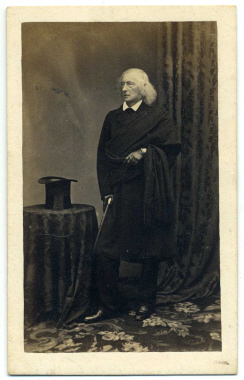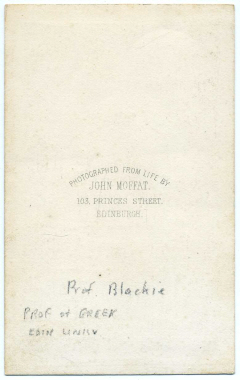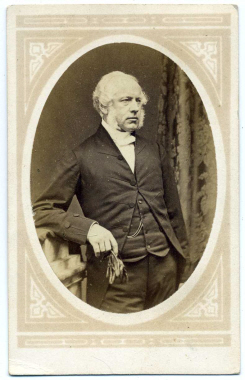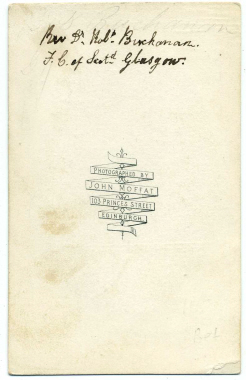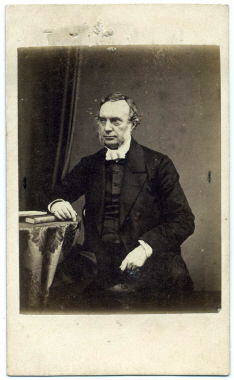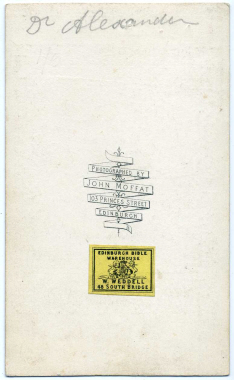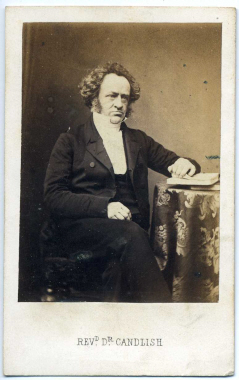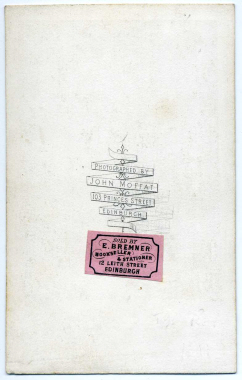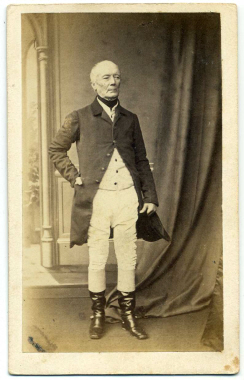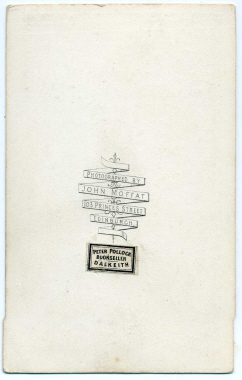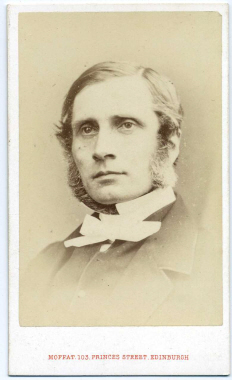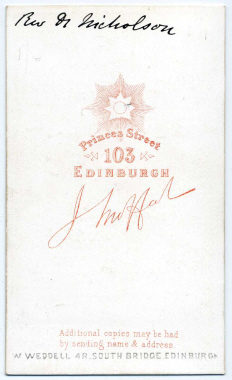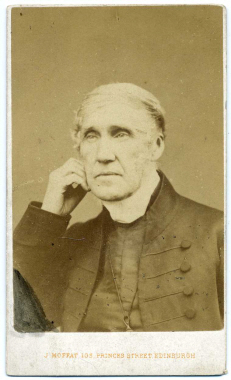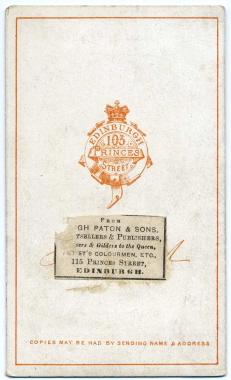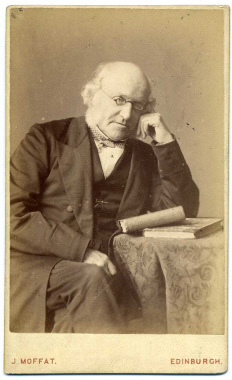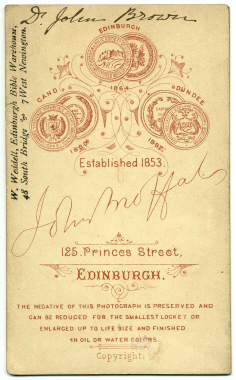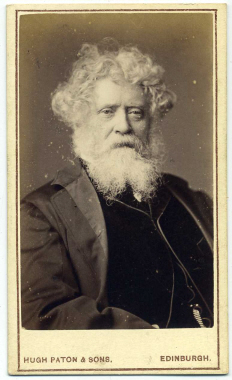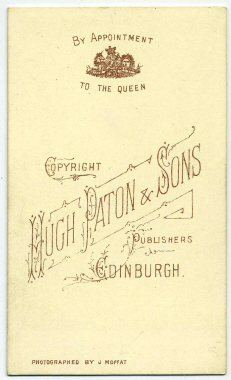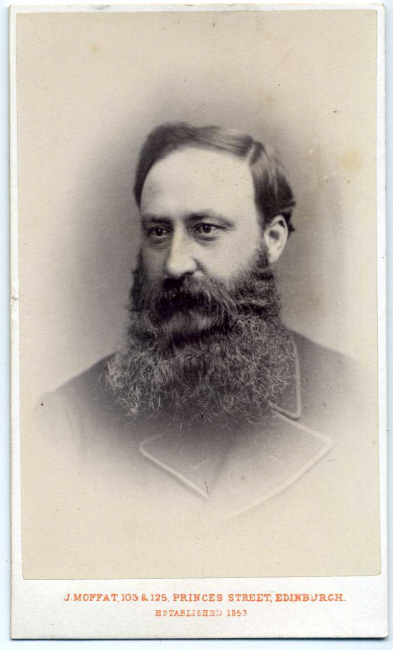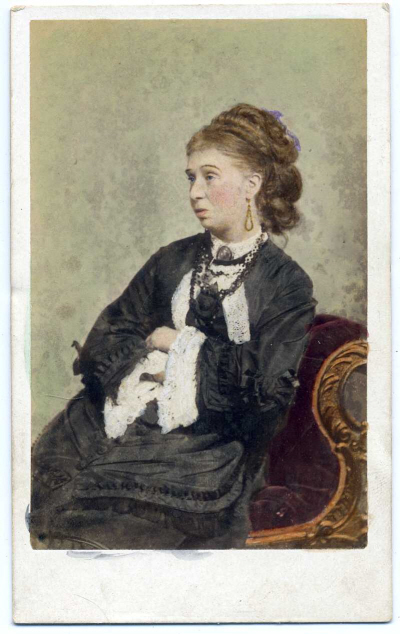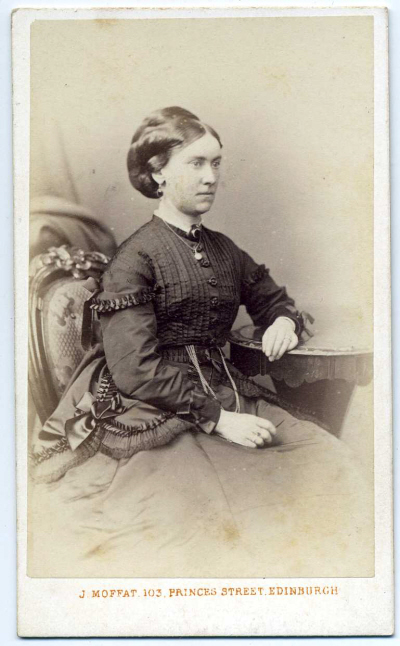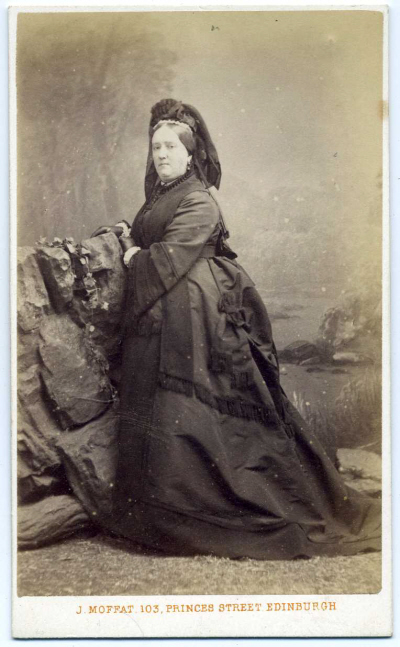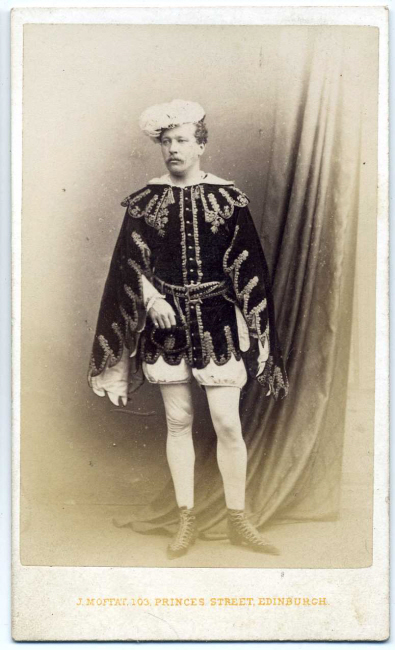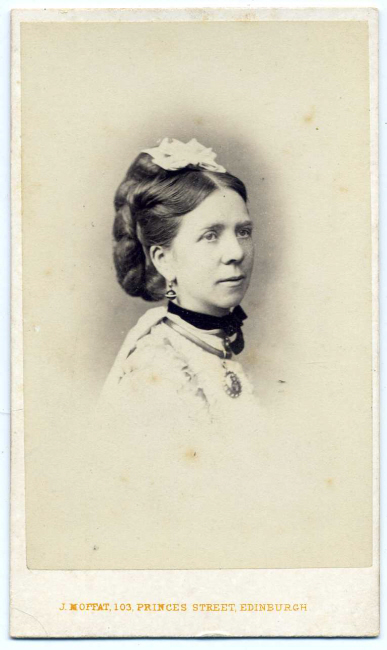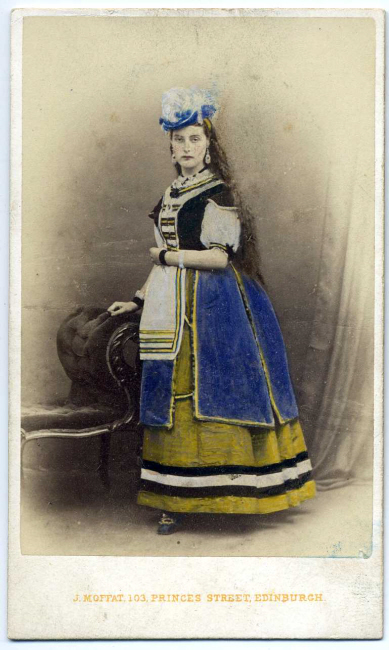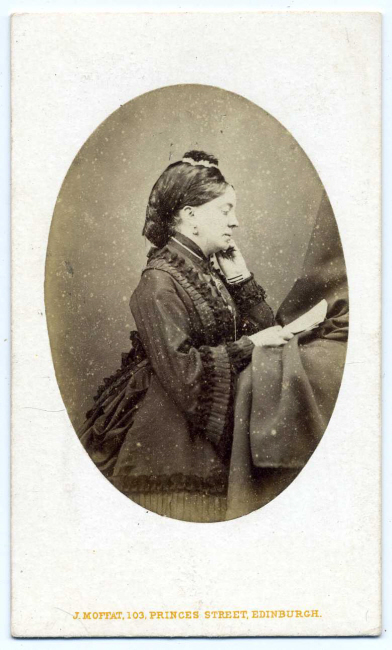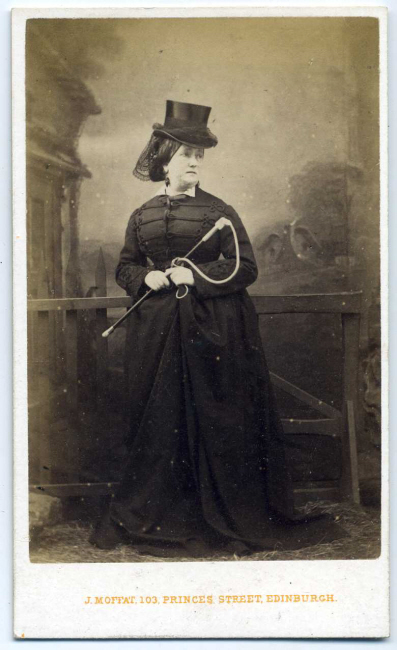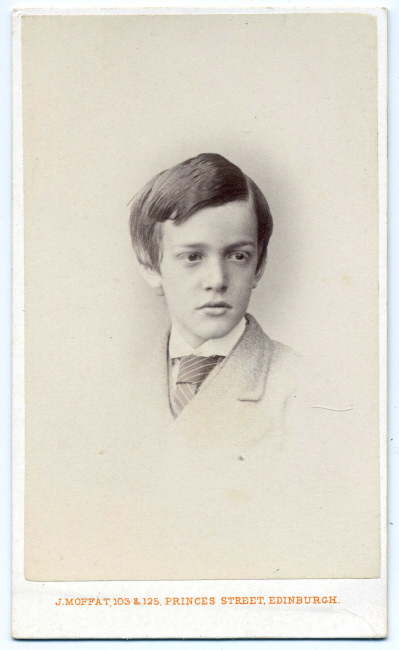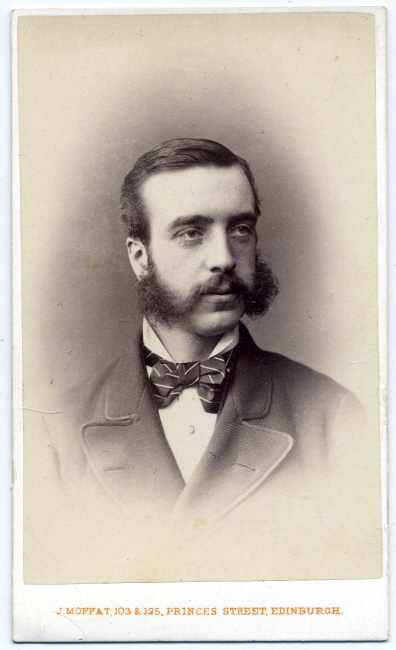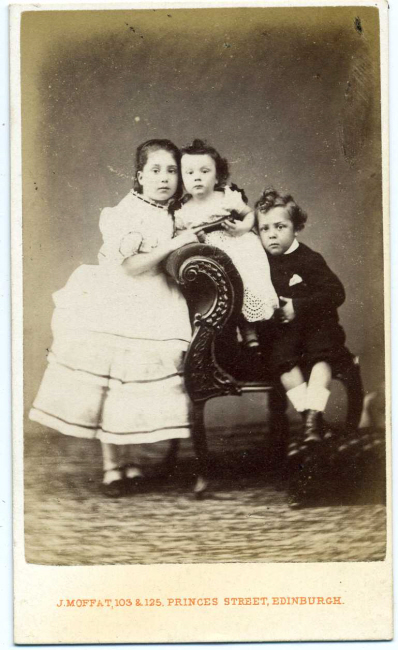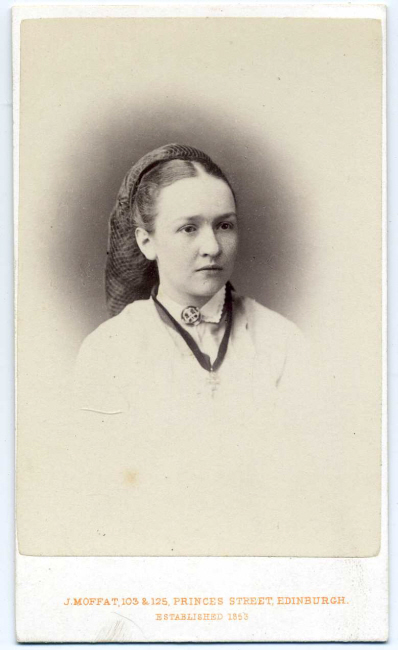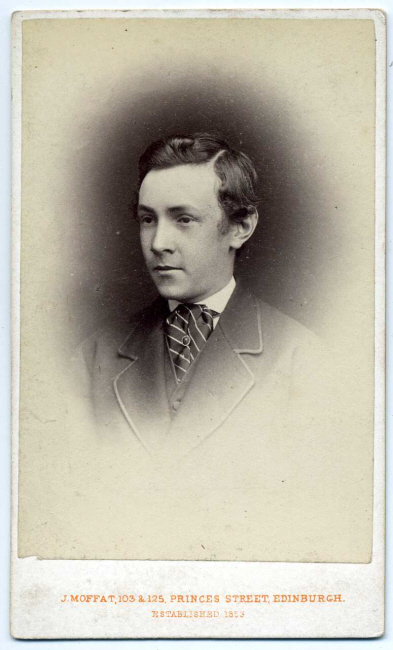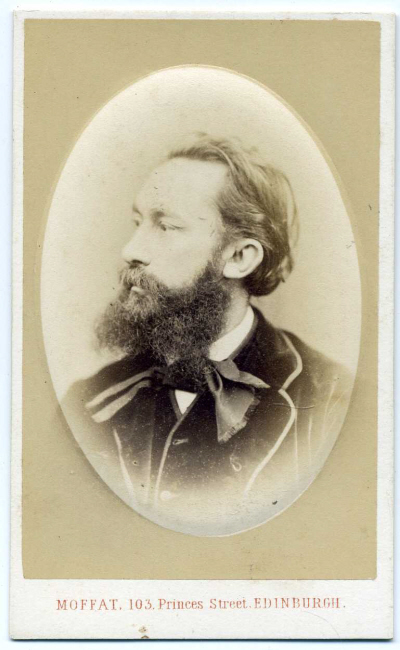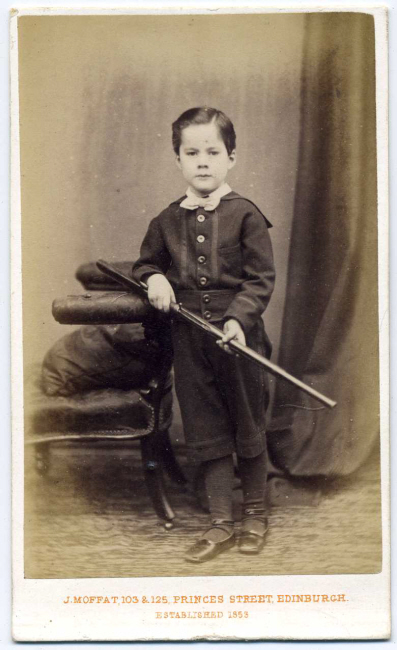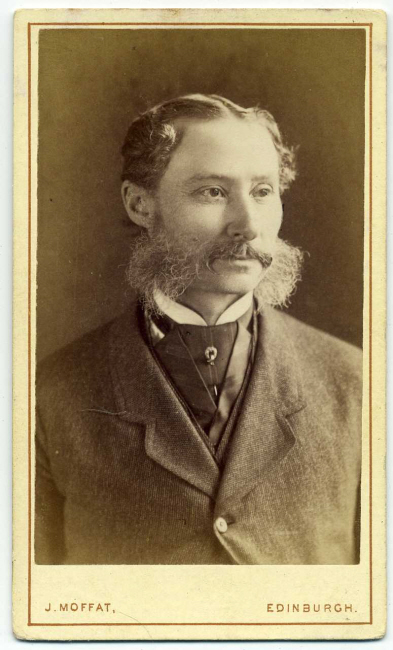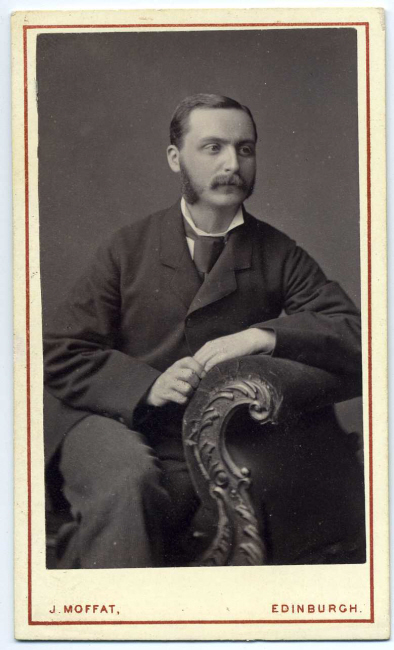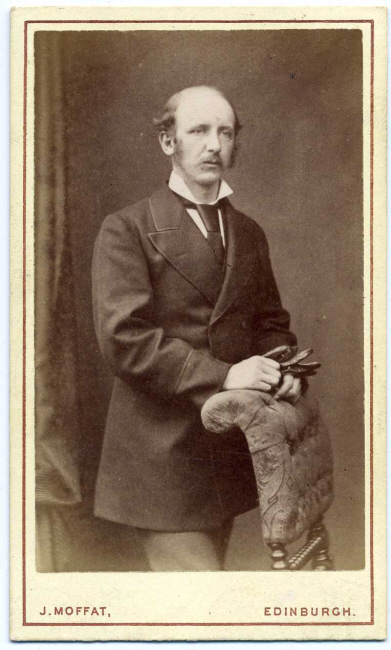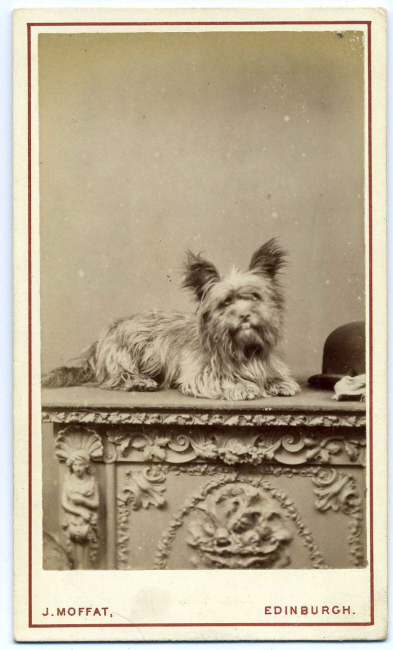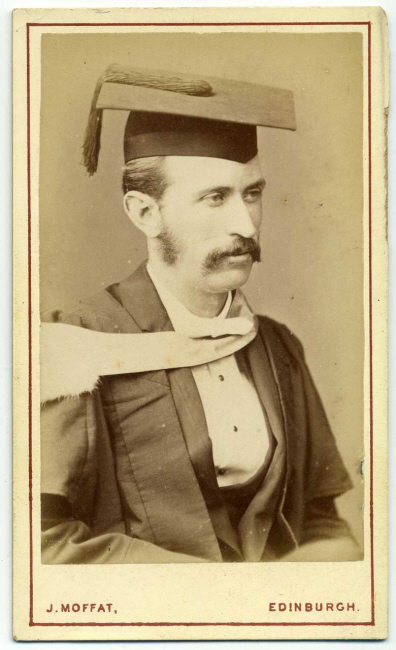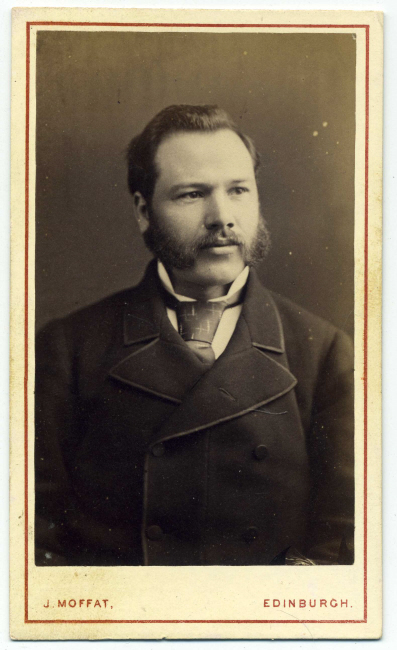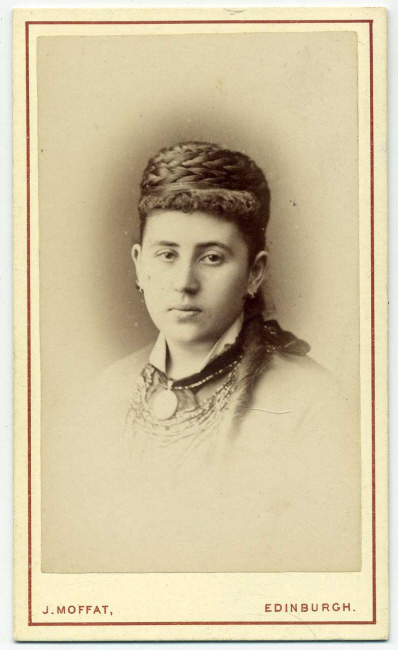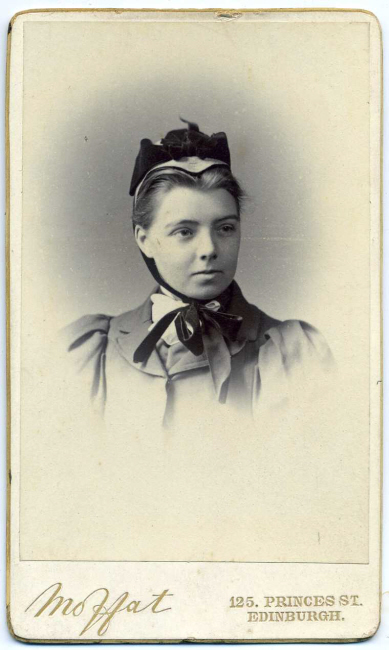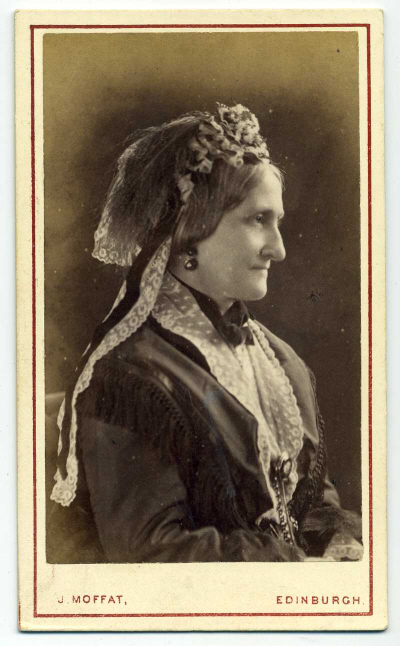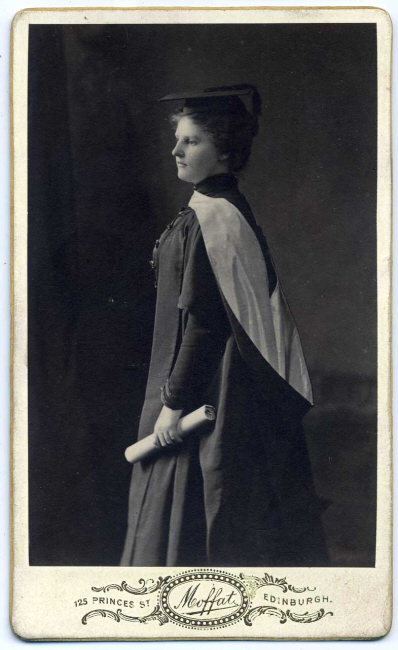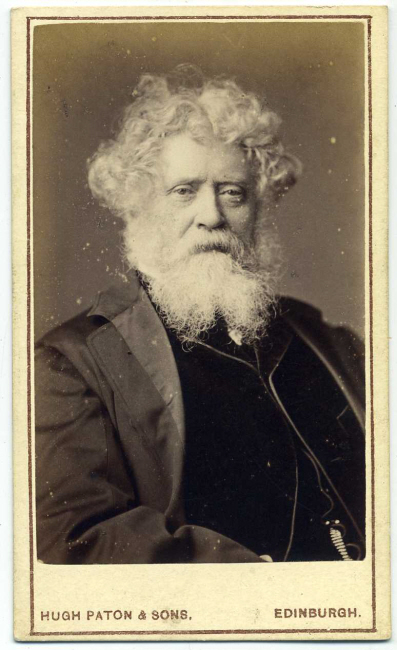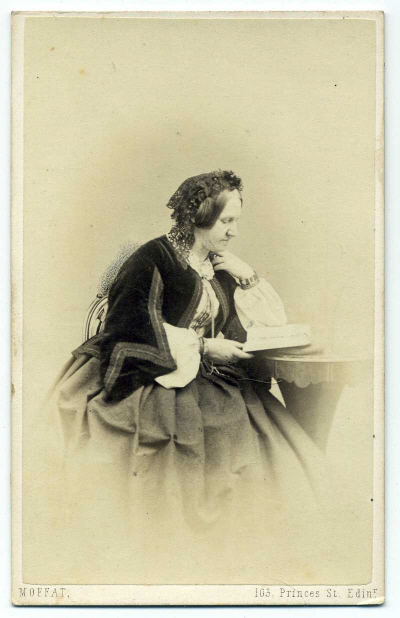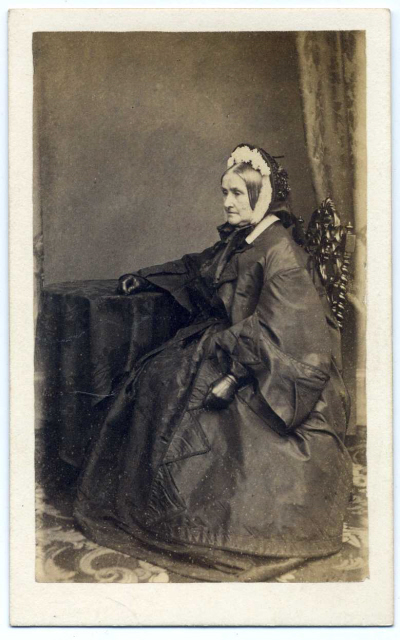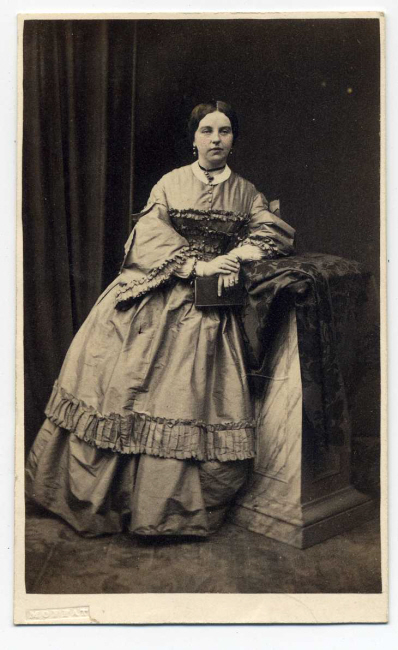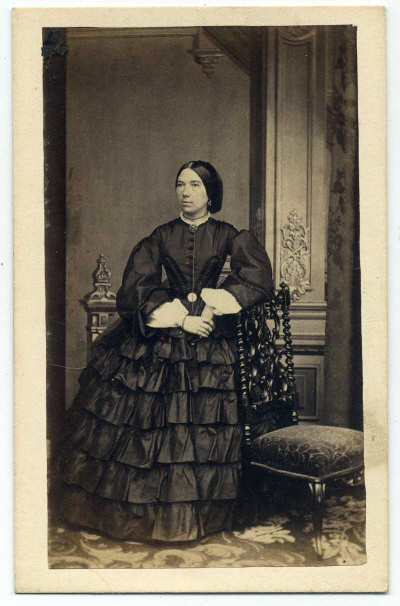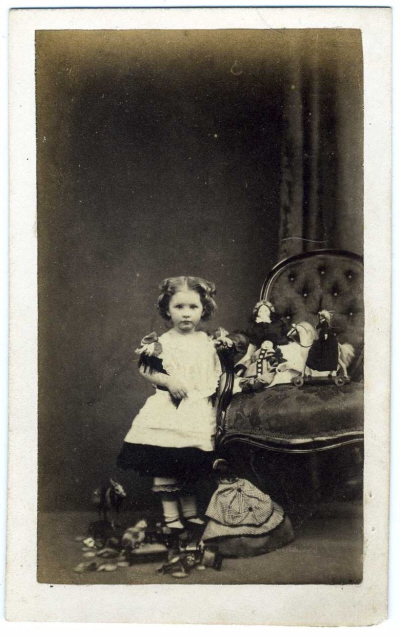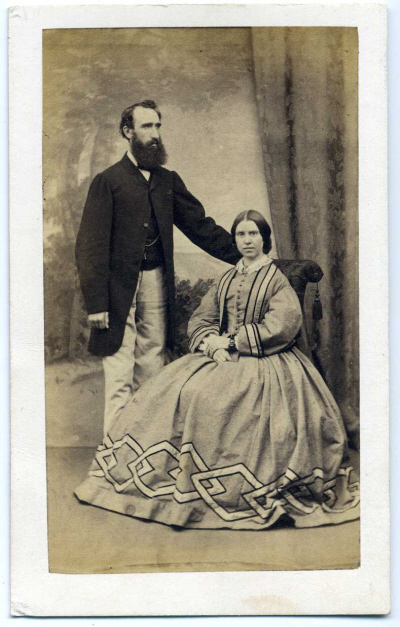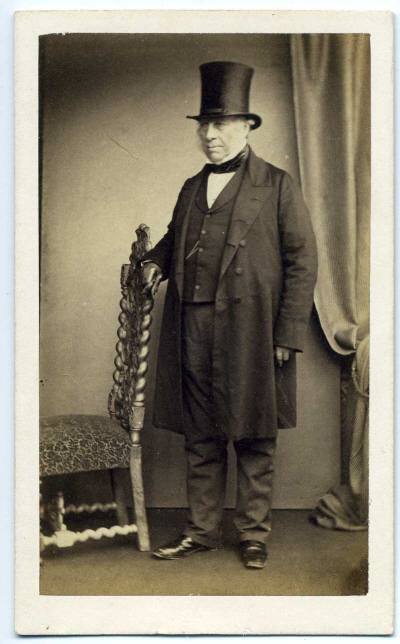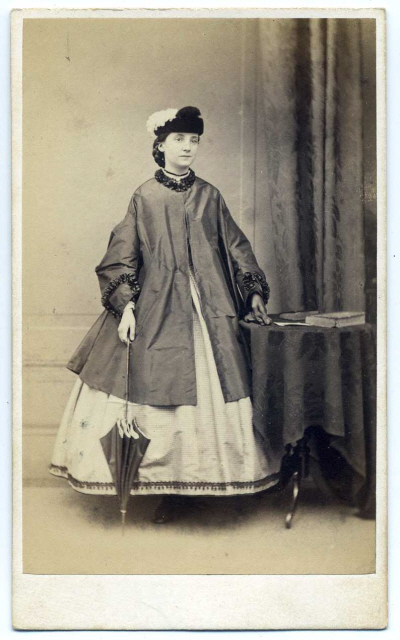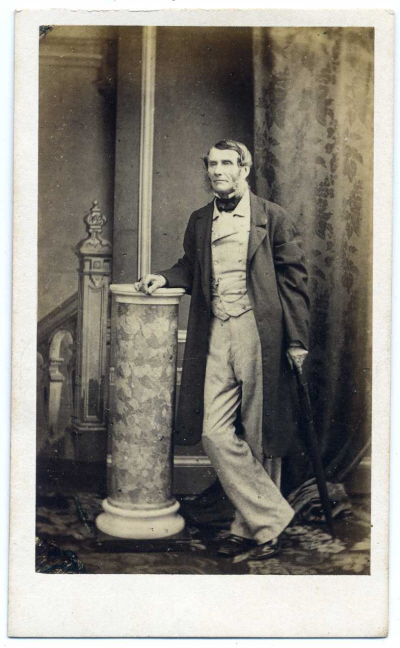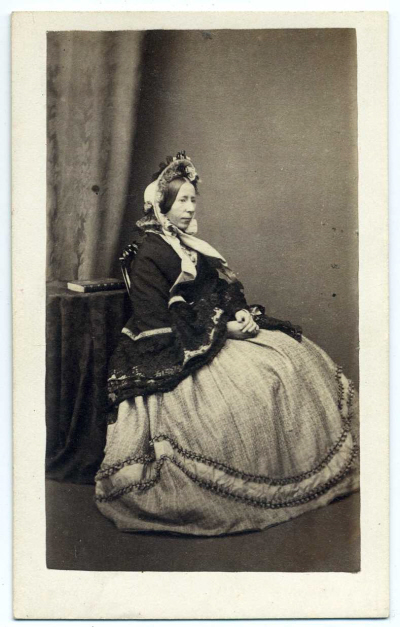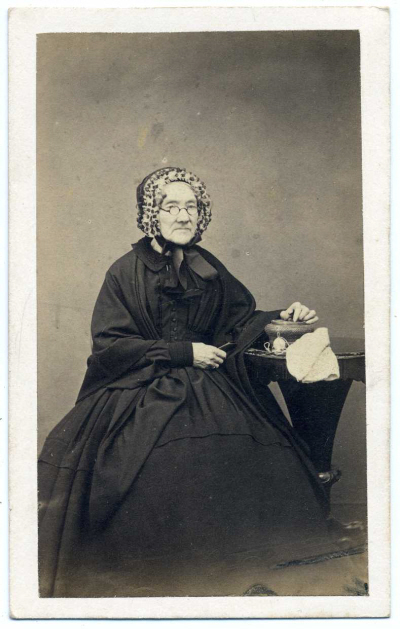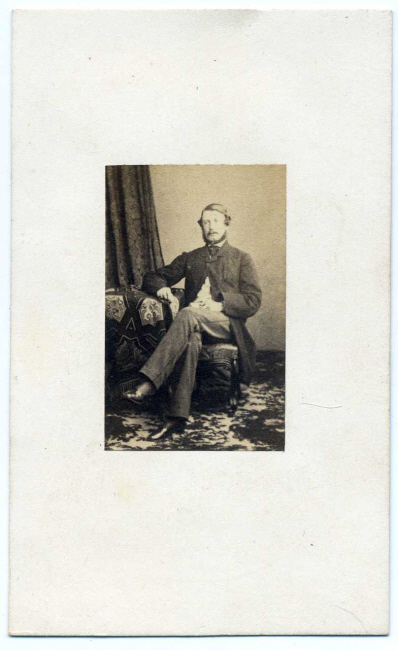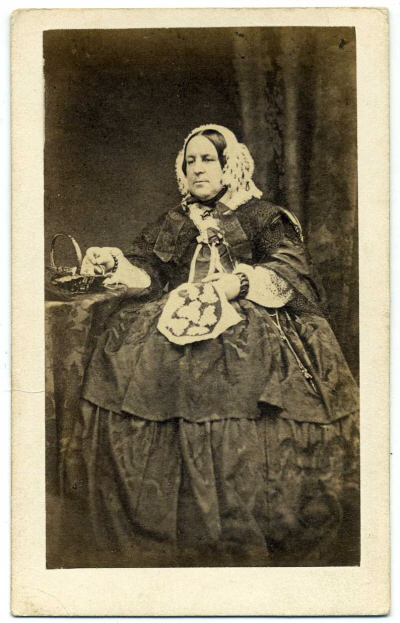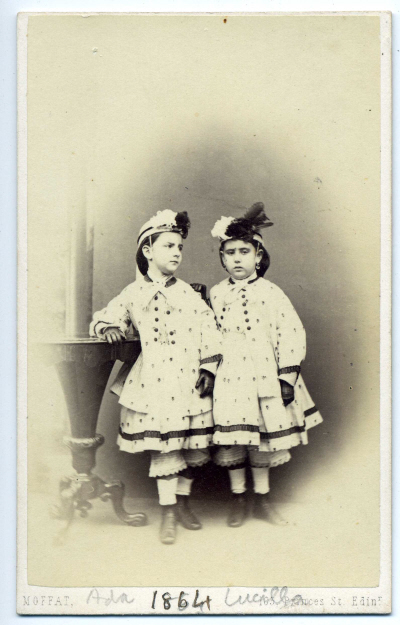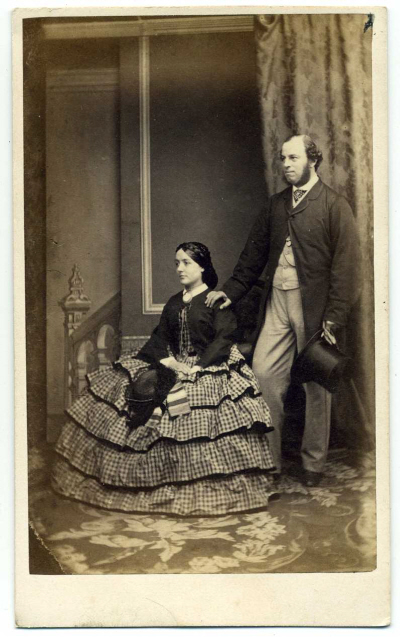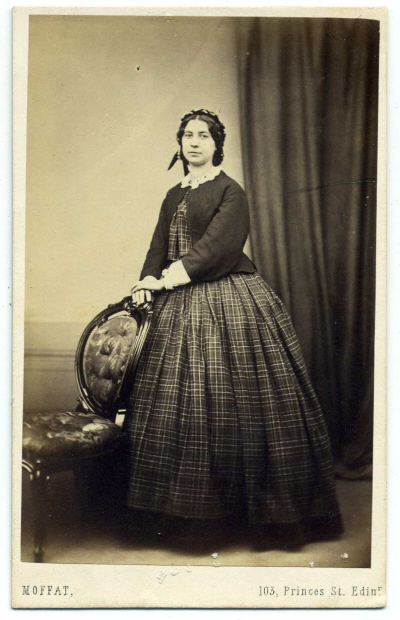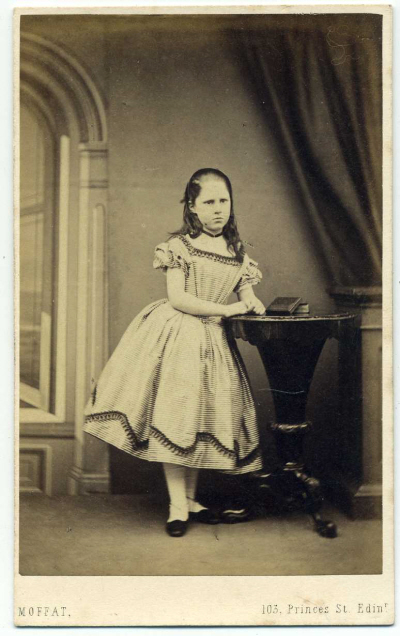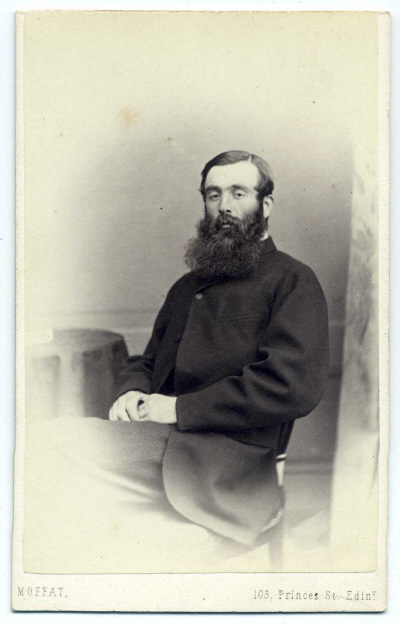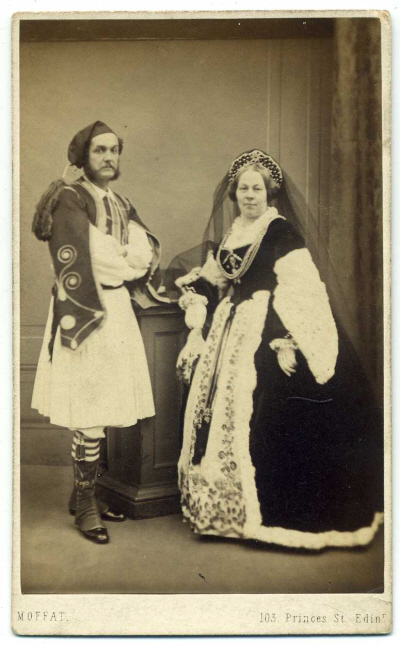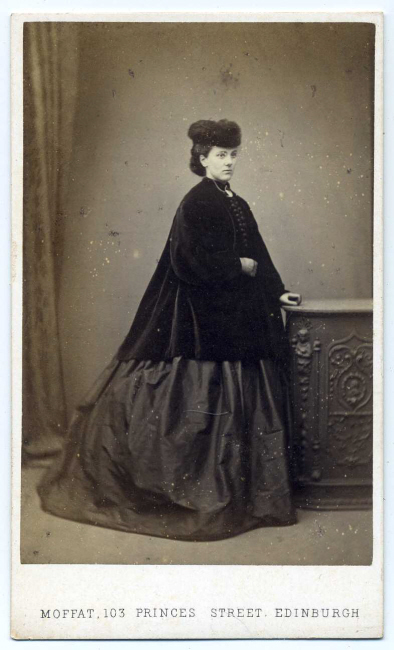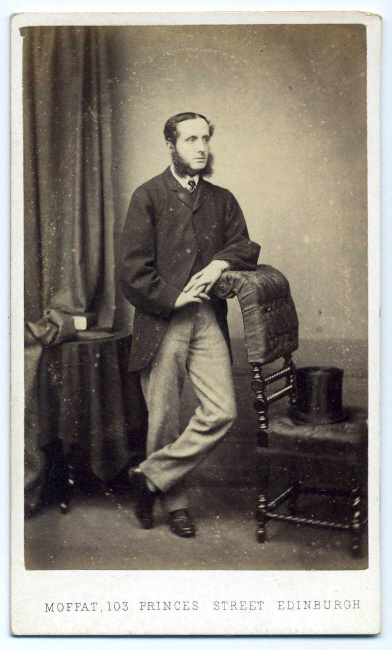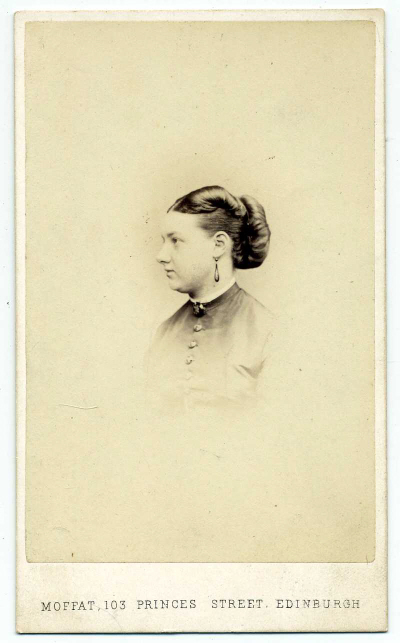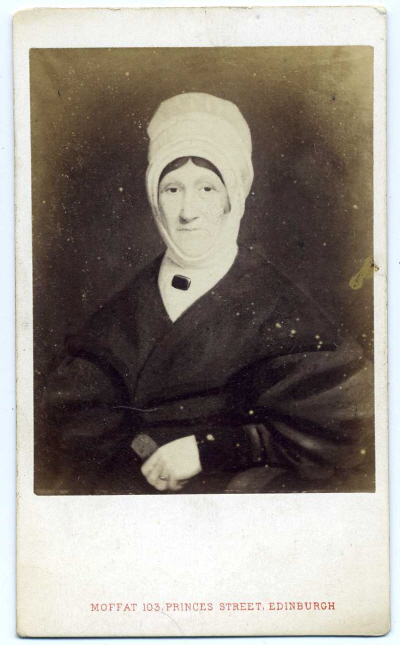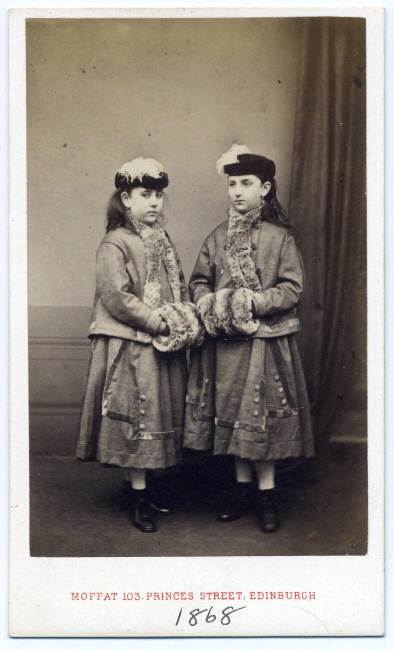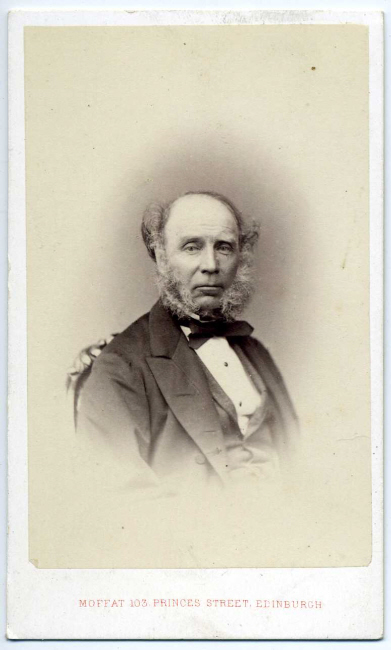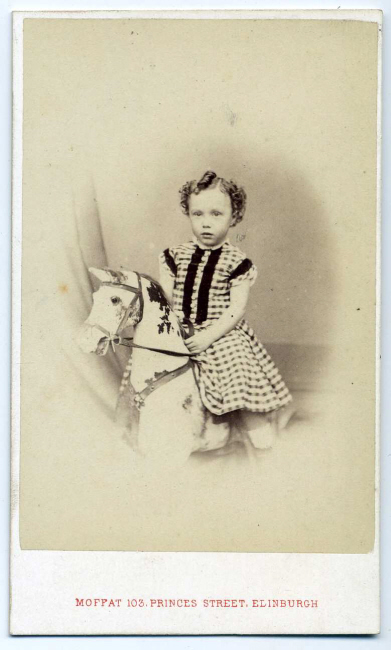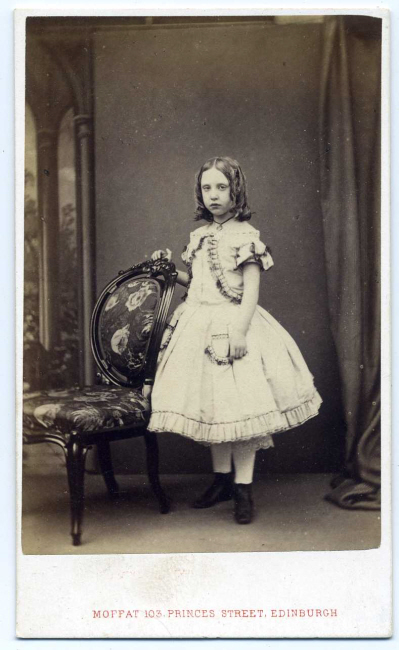John Moffat 1819 – 1894
Photographic Business
John Moffat opened his first studio in Edinburgh in 1853.
By 1857 he had established himself in Princes Street and after two more moves he opened his studio at 103 Princes Street in 1861 and stayed there until 1875 when he switched full time to larger premises at 125 Princes Street.
John Moffat died in 1894 but the firm continued in his name under the leadership of his eldest son, Frank Pelham Moffat.
There are mentions in the 1890s of the firm being called Moffat & Son but no cartes de visite have yet been found with that precise name on.
The studio was advertised from 126 Princes Street in 1923 and was finally taken over by E R Yerbury in 1962.
Two of the studios also housed the business of the photographer James Brown Knott, John’s wife’s brother.
Census
1841 – not found
1851 – age 31, at 1 Windsor Street, Edinburgh with his daughter Ellen J Moffat and a servant. Occupation – picture engraver master.
1861 – age 41, at 65 Princes Street, Edinburgh with his wife Sophia M Moffat, four children and two servants. Occupation – photographer.
1871 – age 51, at 34 Greenhill Gardens, Edinburgh with his wife Sophia M Moffat, seven children, a companion and three servants. Occupation – artist photographer.
1881 – age 61, at 40, Greenhill Gardens ‘The Avenue’, Edinburgh with his wife Sophia M Moffat, eight children and two servants. Occupation – artist photographer.
1891 – age 71, at 40, Greenhill Gardens, Edinburgh with his wife Sophia M Moffat, three children, one grandchild and three servants. Occupation – photographer.
John Moffat
This biography follows the general format of biographies on this site but some details have been left out as there is already much written about John Moffat of Edinburgh. However, the biography does contain much new information as well as many images that have never been published before.
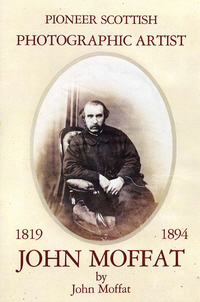
Pioneer Scottish Photographic Artist Book
The fullest account available is contained in the book ‘John Moffat, Pioneer Scottish Photographic Artist’ which was written by his great grandson, the late John Spencer Moffat, and published in 1989 by J S M Publishing. The book is sometimes available second hand on ebay.
Whilst all of the photographs in use here are now part of the Victorian Image Collection, some were originally collected by David Hooper over many years. David is a retired photograph dealer, researcher and keen Moffat enthusiast who latterly corresponded with John Spencer Moffat, the author of the book above. David’s Moffat collection of photographs, correspondence and research papers were passed onto the Victorian Image Collection and have helped to inform what follows. David also wrote an article on dating Moffat’s card mounts which was published in November/December 1993 in the PhotoHistorian, the quarterly magazine of the Historical Group of the Royal Photographic Society.
Another source of information is at http://www.edinphoto.org.uk/pp_i/pp_moffat_0.htm , Peter Stubbs’ excellent website about the history of photography in Edinburgh; and much more about Edinburgh besides.
As mentioned, these biographical notes try to cover some new ground and concentrate mainly on updating the identification of the different photographic mounts used by the firm during John Moffat’s lifetime.
Of added interest will be the slide show of excellent images by John Moffat which is at the end of this biography. These images are shown on line for the first time.
John Moffat was born on the 26 April 1819 in Aberdeen, Scotland into the family of Francis Moffat (b.1782) – a bookbinder – and Elizabeth Moffat (nee Rankin – aka Rankine). He grew up in a family of three sisters and one brother but would have had another sister and two other brothers had they not died very young before he was born.
Not a lot is known about John’s childhood but his father appears to have been interested in the arts and sciences. He was also keen on education and John learnt French at school, a skill which he used later in his photographic researches.
In later life John Moffat went on to become an engraver, an accomplished photographer, an outstanding businessman, a water colourist and a musician.
1847 By 1847, at the age of 28, John Moffat appears in directories as having his own business as an engraver at 24 Gardiner’s Crescent, Edinburgh. He continued to advertise from that address until at least 1849.
1847 On the 19th May 1847 John married Ellen Notman (aka Helen Notman) at South Leith, Midlothian, Scotland.
1849 John’s first child, Ellen Jane Moffat, was born c 1849 according to the 1851 census when she was stated as being two years old. Ellen was also known as Nelly. She grew up to work in the photography business and was living with John in 1881 according to the census that year despite her mother and father getting a divorce many years beforehand.
1850 John was still advertising as an engraver but from 1 Windsor Street, Edinburgh and continued there until at least 1852.
1851 The census in 1851 shows John, aged 31, at 1 Windsor Street, Edinburgh with his young daughter Ellen J Moffat and a 20 year old servant called Margaret Rae. His occupation was stated as a picture engraver master. It is almost certain that John and his wife Ellen had parted, and more probably had divorced, at this stage.
1851 On the 22 June 1851 John married his second wife, Sophia Maria Knott, whose brother was the photographer James Brown Knott. John and Sophia were married in Edinburgh.
1853 John Moffat started his first photographic studio in 1853 at 3 Nicolson Square, Edinburgh but he was still advertising his skills as an engraver from the same address in 1854; apparently he was migrating from engraver to photographer during this period. He certainly confirmed 1853 as the date that his photography business was established by printing the fact on the reverse of his carte de visite mounts.
1854 John’s second child, and his first child with his new wife Sophia, was born in 1854 and named Frank Pelham Moffat. Frank was very involved with the family firm from the early 1870s and he eventually took over when his father died in 1894. Frank was also a fine photographer and was involved at an early stage in colour photography – probably using the Autochrome process.
1855 John Moffat is said to have taken a set of daguerreotype photographs of Queen Victoria and Prince Albert when they visited the Crystal Palace Exhibition in London in 1855 although the whereabouts of these photographs is not now known.
1856 Another child, Sophia Elizabeth Moffat was born in 1856. She never married and lived on until the 1930s.
1856 The Photographic Society of Scotland was formed in March 1856 and John Moffat was an active member so he would have met many early photographers and photographic researchers including Sir David Brewster and William Henry Fox Talbot who John later photographed in his studio at 103 Princes Street in 1864.
1856 – 1858 A unique Day Book is still in existence from this period and contains details of the studio customers, charges, expenses and profits on a weekly basis. It also records, interestingly, details of the weather which appears to have had a significant effect on business turnover. A short transcript from the book is shown below
Week Remarks Amount Expenses Profits
Aug 30 Queen’s visit. Partly dull and rainy £45/19/6 £14/6/6 £31/13/-
Nov 1 Weather fine £42/13/- £10/17/3 £31/15/9
Nov 8 Dull and wet £26/6/6 £9/5/3 £17/1/3
Nov 15 Absent two days & half – weather cold £19/4/10 £9/3/6 £10/1/4
Nov 22 Fine mornings, dark afternoons £25/16/- £10/4/1 £15/4/11
1857 John and Sophia had a second son, Fred (John F) Moffat, in or about 1857. John went to France and eventually went to Canada to become a farmer.
1857 Also in 1857, probably in June, John Moffat moved his studio to 19 Princes Street but stayed there for only about a year.
1858 By 1858 John had moved his studio again to 60 Princes Street, an address that is connected to his brother in law James Brown Knott. At that time, the carte de visite had not become popular and John would have still been producing ambrotypes in smart little cases.
1859 Kate Rankin Moffat was born on the 30 November 1859 and remained a spinster all her life. She is said to have had an active life and embraced new ideas such as motor cars. She died in 1954 in Edinburgh.
1860 Cartes de visite produced at 60 Princes Street, Edinburgh
No pre-printed carte de visite mount has yet been found with the 60 Princes Street address on it although the studio operated until the latter part of 1860 and so encompassed the start of the carte de visite era. It is inconceivable that the entrepreneurial John Moffat did not produce cartes de visite when they first became popular at the beginning of 1860.
Carte de visite mount Type 100 (see the Gallery at the end of this page) has only the name MOFFAT impressed into the front of it; there is no printing on the back nor the front and no address. However, the impressed name is identical to that imprinted on Moffat’s stereo-cards from the 1850s. (see below)

‘Moffat’ impression from a stereo-card (c 1855) and a carte de visite (c 1860)
It is, therefore, not unreasonable to say that mount Type 100 was used at 60 Princes Street.
Research into the images on this style of mount by Jayne Shrimpton, one of the country’s leading fashion historians www.jayneshrimpton.co.uk , also supports this assumption.
Below is an early stereo-card by John Moffat with the MOFFAT impression shown in the bottom left hand corner.
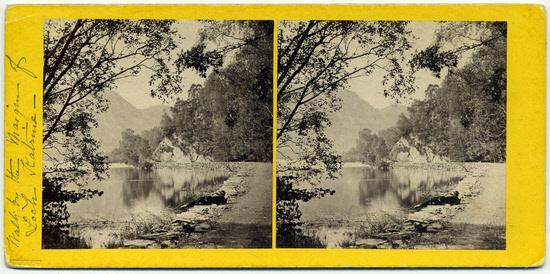
Stereo-card by John Moffat – front
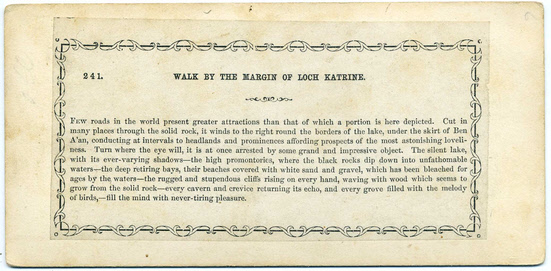
Stereo-card by John Moffat – reverse
1861 The census shows John Moffat, at the age of 41, living at 65 Princes Street, Edinburgh with his wife Sophia M. Moffat and four children; Frank P Moffat (age 7), Sophia E Moffat (age 5), John F Moffat (age 3) and Kate R Moffat (age 1). His occupation is shown as a photographer. Also in the household were Eliza Hunter a 22 year old servant from Broughty in Lanarkshire and Marian Crabbie another 22 year old servant from Edinburgh.
1861 Arthur Elwell Moffat was born later in 1861 and went on to be a painter in watercolour and oils as well as a musician. He exhibited on many occasions and won medals for his work. It is likely that he worked in the family business as a colourist. Arthur died in 1943.
1861 John Moffat moved his studio again, this time further west along Princes Street to better premises at 103 Princes Street where he stayed until 1875. In the same year he became a member of the Council of the prestigious Photographic Society of Scotland.
1863 The family continued to grow when Alfred Edward Moffat was born on the 4th December 1863. Alfred became very musical and played the violin and was a musical arranger. He studied in Germany where he met a local girl and got married. Alfred died in the 1950s.
1864 Ada Kennedy, her sister, her dog and her family photographs
Some families went to the same photographer many times over the years to record their children as they grew up.
Here are several photographs of Ada Kennedy as a girl, with her sister Priscilla, which were taken by John Moffat in Edinburgh between 1864 and 1868 . Watch her grow up in the photographs below.
The last two photographs dated 1878 show Ada as a married woman and her husband Mr. Todd.
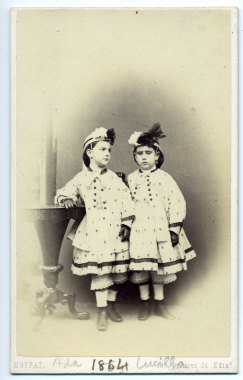
1864 02
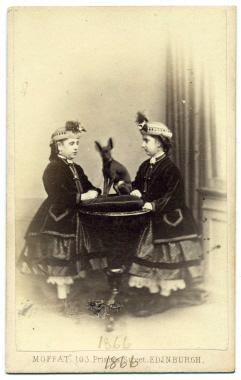 1866 01 |
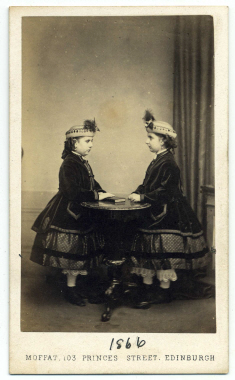 1866 02 |
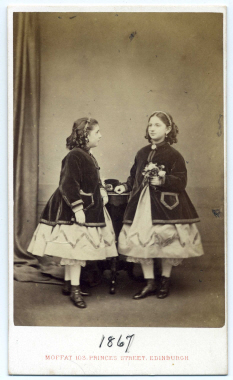 1867 02 |
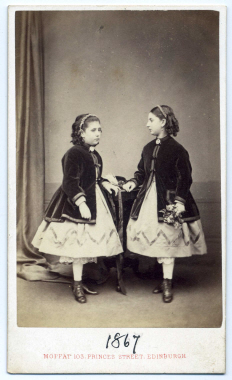 1867 03 |
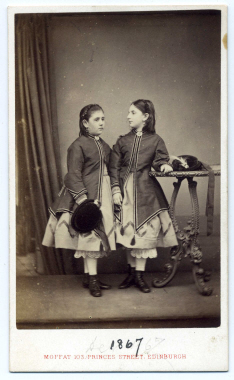 1867 04 |
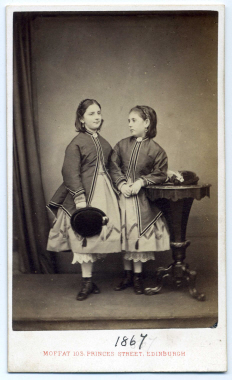 1867 05 |
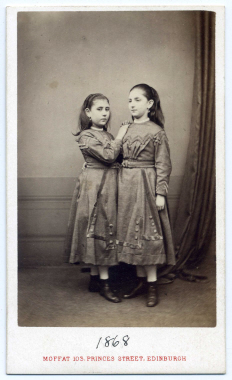 1868 02 |
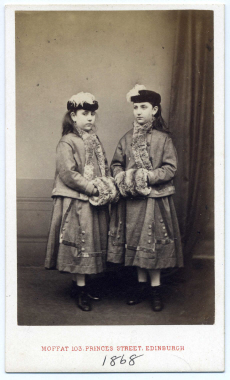 1868 01 |
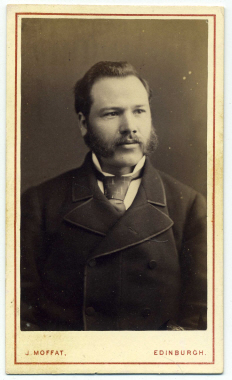 1878 05 |
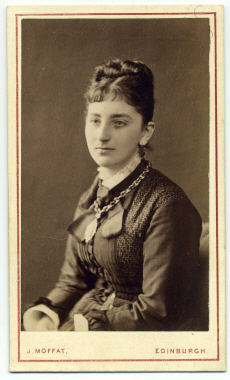 1878 04 |
1866 John and Sophia’s last child was a daughter called Alice May Moffat. She grew up and married a prominent local businessman – James Watt – a member of the Edinburgh Stock Exchange.
1870 A tale of two images
Here is an interesting story of two images by different photographers; Willam McCraw and John Moffat – both of Edinburgh.
It was not unusual for Victorian studios to provide copies of cartes de visite at the time they were taken and also at a later date for one reason or another; sometimes to send extras to friends or sometimes, sadly, as a memento when the sitter died.
However, it is usually the case that extra copies were purchased from the original photographer who would have had the original negative on file and could produce good quality copies. Occasionally, however, clients went to a different photographer to get copies and this had to be done by re-photographing the original image, making a new negative and pasting the resultant positive photograph onto the then current mount of the photographer who made the copy. This usually resulted in a copy of lesser quality, but not always. See the two examples below.
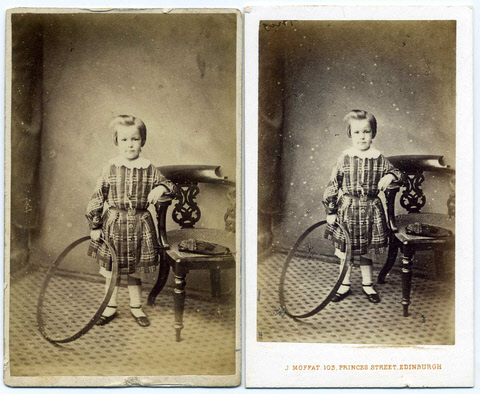
A copied carte de visite by John Moffat c1870 – front
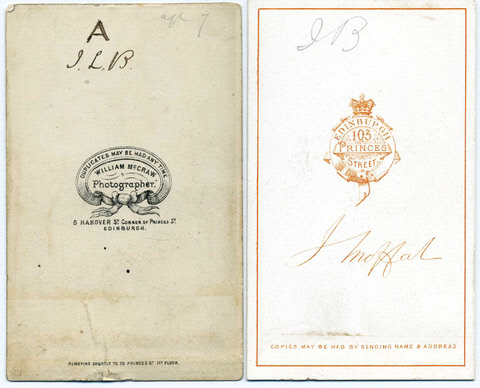
A copied carte de visite by John Moffat c1870 – back
By researching this pair of photographs of a little boy whose initials were J L B, it can be seen that the image on the left is the original photograph that was taken in 1862 or 1863 when William McCraw was planning to move studio (see the wording at the bottom of the reverse of the mount on the left which says ‘Removing shortly to 79 Princes Street, 1st. Floor’). The photograph on the right is a copy by John Moffat and was taken seven or eight years later in 1870.
However, McCraw was still in business in Edinburgh up to 1883 so why did the customer go to John Moffat? The reason the customer did not go back to McCraw for the copy is probably that, in 1868, McCraw moved from Princes Street in the centre of the city to West Catherine Place which is nearly two miles out of town to the west.
1871 The census of 1871 shows John as being 51 years old and living at 34 Greenhill Gardens, Edinburgh with his wife Sophia M Moffat who was 50. John’s occupation was recorded as being an artist/photographer.
The household also included seven children; Ellen I Moffat (age 22), Frank P Moffat (age 17), John G Moffat (age 13), Kate R Moffat (age 11), Arthur E Moffat (age 9), Alfred E Moffat (age 7) and Alice M Moffat (age 4). Sophia Elizabeth Moffat was missing from the census at that address. She would have been 15 years old.
Also living at the same address were Isabella C Robertson who was a 29 year old companion and governess from Edinburgh, Eliza Stewart a 28 year old cook from Inverness, Jean Harrold a 28 year old nursemaid from Kirkwall in the Orkney Islands and Euphamia L Gourlay a 19 year old housemaid from Edinburgh. A full and, no doubt, busy household.
1871 The Photographic Society of Scotland, of which John was a Council Member, was wound up in 1871 and was effectively replaced by the Edinburgh Photographic Society. John Moffat later became the President of the Edinburgh Photographic Society until shortly before his death in 1894.
1873 This was a major year in the life of the Moffat photographic enterprise as John moved into a prestigious studio at 125 Princes Street. This studio was run in parallel with the one at 103 Princes Street until 1875 and then became the sole outlet until the 1920s; way after John Moffat’s death. Two very interesting descriptions of John’s mighty studio are included in the book mentioned at the beginning of this biography and extracts are touched upon below under the headings 1876 and 1887.
1875 John was a determined businessman and turned to the courts on more than one occasion. In the autumn of 1875 John Moffat took another well known Edinburgh photographer, Robertson Ross of Ross & Pringle, to court for non payment for photographic work carried out. He won his case – see below.
Edinburgh Evening News – Friday 22 October 1875
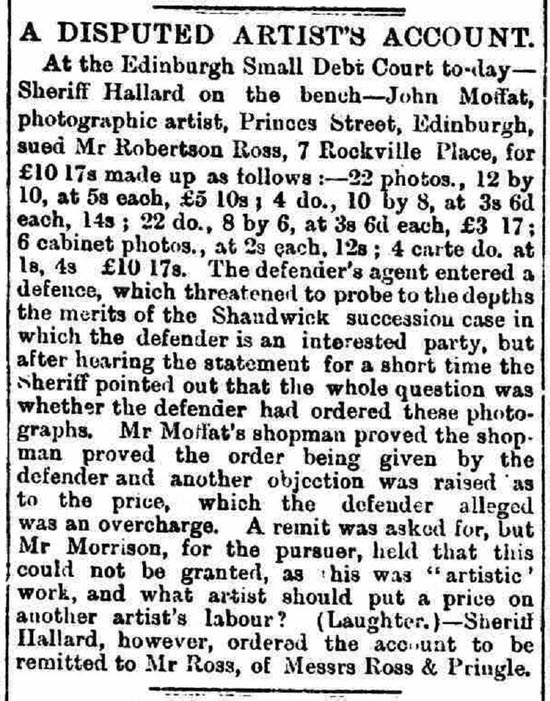
John Moffat v Ross & Pringle – court case 1875
1876 An interesting article appeared in the British Journal of Photography in August 1876 which described a visit to Moffat’s studio at 125 Princes Street. Included in the article is a comment on John Moffat, the man – as follows ‘ To the credit of Mr. Moffat, be it said that his present position as a leading high-art photographer has been solely due to his own inherent talent, deep thought, indomitable perseverance, and commendable enterprise’ . A further extract about the studio is worth repeating – ‘ Entering the premises by a beautiful sash doorway, we are ushered in to the first floor of the building. Here we find a suite of rooms, which are richly and artistically appointed, facing Princes Gardens, and having the grand old castle as a background……..’.
There is a full transcript on page 20 of the Moffat book mentioned above.
1879 John Moffat again took to the courts to sue his removal firm for the loss of goods during transit. The removers were said to have stopped off for a pint in Hope Street. He won his case initially but lost it on appeal. However, the judgement was later overturned at a higher court and he eventually won the day. See below.
Edinburgh Evening News – Monday 01 December 1879
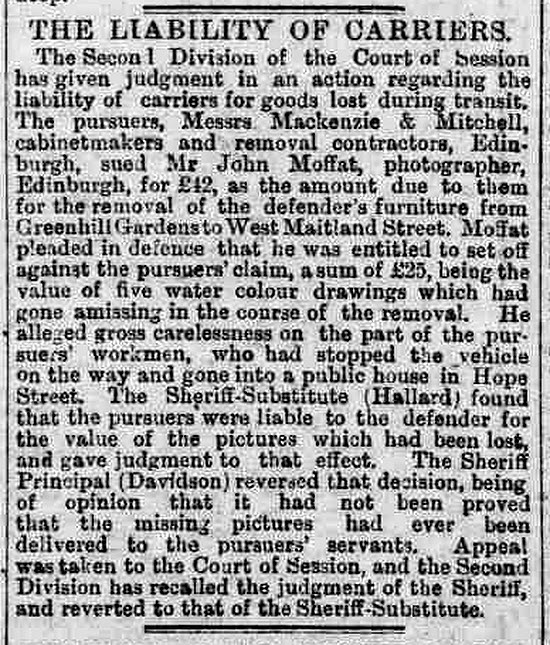
Report on court case when John Moffat sued removal contractors in 1879
1881 In the 1881 census John Moffat, who was aged 61, was living at number 40, Greenhill Gardens ‘The Avenue’, Edinburgh with his wife Sophia Maria Moffat, eight children and two servants. John’s occupation was recorded as ‘photographer master employing 6 men, 2 boys, 11 women’.
The children were Ellen J Moffat (age 32) from his first marriage although her mother’s name was given as Sophia Maria Moffat, Frank P Moffat (age 27) – a photographer, Sophia E Moffat (age 25), John F Moffat (age 23) – an artist landscape painter, Kate R Moffat (age 21), Arthur E Moffat (age 19) – an art student, Alfred E Moffat (age 17) – a scholar and Alice M Moffat (age 14) – also a scholar.
There were also two servants in the house; Margaret Isbister (age 32) from Stromness, Orkney who was the cook and Mary Kelman (age 22) from Peterhead, Aberdeenshire who was the housemaid.
This was a very full household with all eight children still at home and with ages ranging from 14 to 32.
1886 John obviously photographed the entertainers of the day as well as the gentry of the neighbourhood as he had cause to sue an actress and singer named Miss Hetty Chapman for 18 shillings for work done but not paid for. The case came to court on the 27th January 1886 but strangely enough the case was brought four and a half years after the photographs were actually taken. It is not clear if John won his case or not as the newspaper report says it was deferred to a later date.
Edinburgh Evening News – Wednesday 27 January 1886
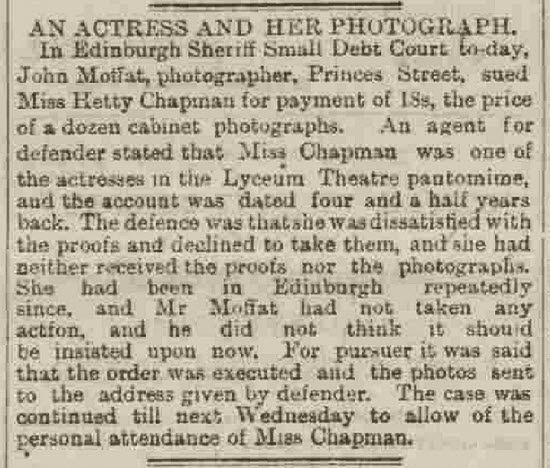
Report on John Moffat’s case against Miss Hetty Chapman 1886
Below is a mention of Miss Hetty Chapman on a music sheet of the period.
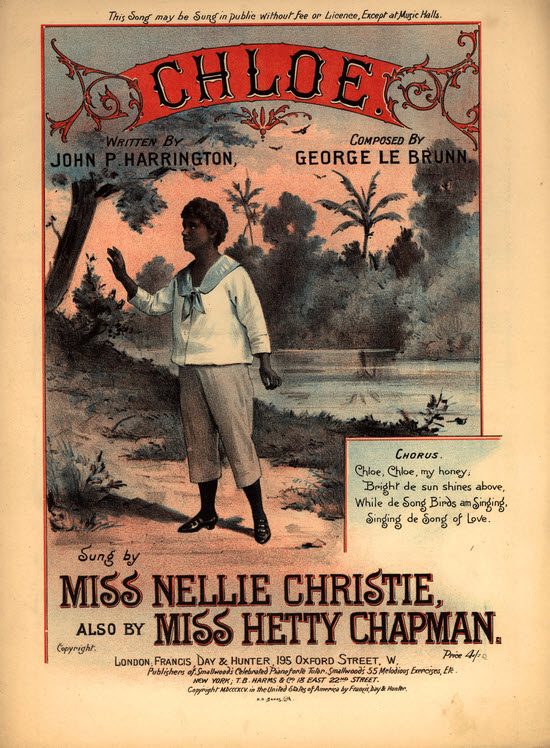
A song sheet for ‘Chloe’ as sung by Miss Hetty Chapman
1887 Another interesting article about John’s studio appeared in the Mercantile Age on the 9th September 1887 which described a visit to 125 Princes Street. Again, there is a full transcription in the Moffat book on page 21.
A description of the way that children were photographed was particularly interesting, as follows – ‘Above this room (the main studio) is another room with a stronger light than the one below, and eminently suitable for taking children’s portraits. The cameras used here have wonderfully sensitive pneumatic shutters, so instantaneous and noiseless in their action that frequently the operator can engage the attention of the sitter by some pleasing manoeuvre, and when his educated eye catches a pleasing expression, he can without moving from his position, command chemicals and old Sol to instantly do the rest before the young patron is aware of it.’
In a second section, the reporter comments on John Moffat’s business acumen as follows ‘We are please to notice that everywhere great economy is manifest. Mr. Moffat, understanding the chemistry of his trade, is successful in recovering a very great quantity of his silver. We witnessed the operation of washing and recovering, and we were altogether taken by surprise at the percentage of the chloride of silver recovered’
Other comments from elsewhere also support this view that John Moffat was a canny businessman and that he was always interested in new ideas and processes.
1891 In the 1891 census John Moffat was aged 71 and still living at 40, Greenhill Gardens, Edinburgh with his wife Sophia, three children, one grandchild and three servants. His occupation was still given as ‘photographer’.
John’s children were Frank P Moffat (age 37) – a photographer, John F Moffat (age 33) – an artist portrait painter and Kate R Moffat (age 31) – no occupation given. Also living with them was Frank’s son John F Moffat who was five years old.
The household was supported by three servants; Elizabeth McKay (age 28) from England who was a nurse, Mary Milne (age 30) from Stonehaven, Aberdeenshire who was the cook and Elizabeth Ward (age 21) from England who was the housemaid.
1894 John Moffat died on the 5th. March 1894 and an obituary was printed in the British Journal of Photography in the March issue of that year. A full transcript is included in the book on John Moffat at page 25.
A quote from the end of the obituary is very touching – ‘He was ever kind and considerate to his employees and generous in his treatment of them, while, in ordinary business matters all knew him to be honourable and upright in the highest degree’.
This is a touching, final comment.
~~~~~
1894 John Moffat’s will was proved on the 12 April 1894 in Edinburgh. His executors were his son Frank P Moffat and his wife Mrs. Sophia Maria Moffat.
His personal assets amounted to £5,321.4s.4d less his liabilities and funeral expenses of £321.1s.9d – i.e. net assets of £5,000.2s.7d. This is the equivalent of about £455,000 in today’s money – as at 2013.
His personal assets included ‘household furniture, silver plate and other effects’ valued at £805, several life insurance policies, a debt due to him of £240 from his sister Mrs. Mary Ann Simpson and rents due of £83 on several properties (although the properties themselves are not listed as assets). There is no mention of John Moffat owning a house at the time of his death.
His assets also listed several lots of shares and bonds including
- 100 Scottish Assam Tea Company Limited
- bonds in the Argentine Government
- the Atlantic and Great Western Railway Company – with a written down valuation of just 1s.0d.
- the New York Pennsylvania and Ohio Railroad Company
- various high value bearer bonds and coupons.
Also in his list of assets is the entry ‘ Value of the deceased’s interest in the Assets of the Copartnership (sic) carried on by the deceased and his son Mr. Frank Pelham Moffat as Partners in the business of Photographic Artists at 125 Princes Street, Edinburgh’. Detailed listings also included ‘Stock in Trade’ and ‘Book Debts’ which, all added together, totalled £1,884.18s.6d.
His liabilities amounted to just £242 and funeral expenses amounted to £77.
An interesting item in his list of debts says ‘ Half years rent of business Premises 125 Princes Street is £210.’ This indicates that the premises were owned by another person or company. Whether this is a company owned by other members of the Moffat family or not is, as yet, unknown.
1895 onwards – queries
Here are several references to John Moffat or J Moffat after his death. Can anyone explain if they relate to John or to John’s work, and if so, how?

Edinburgh Evening News – Thursday 25 July 1895
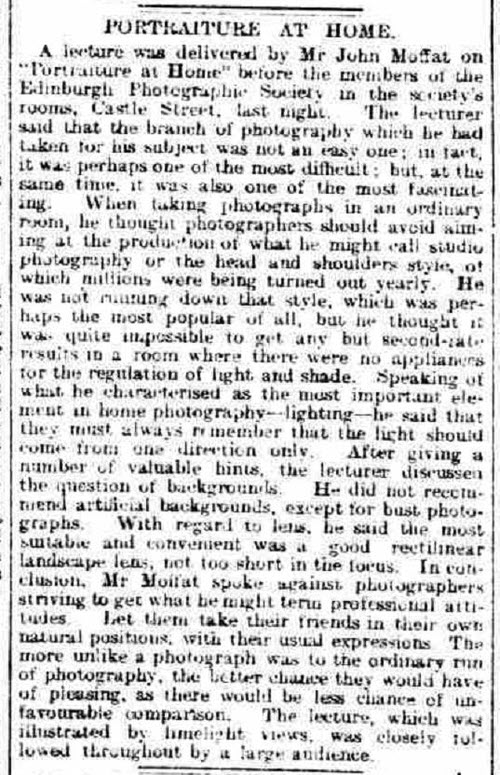
Edinburgh Evening News – Thursday 11 January 1900
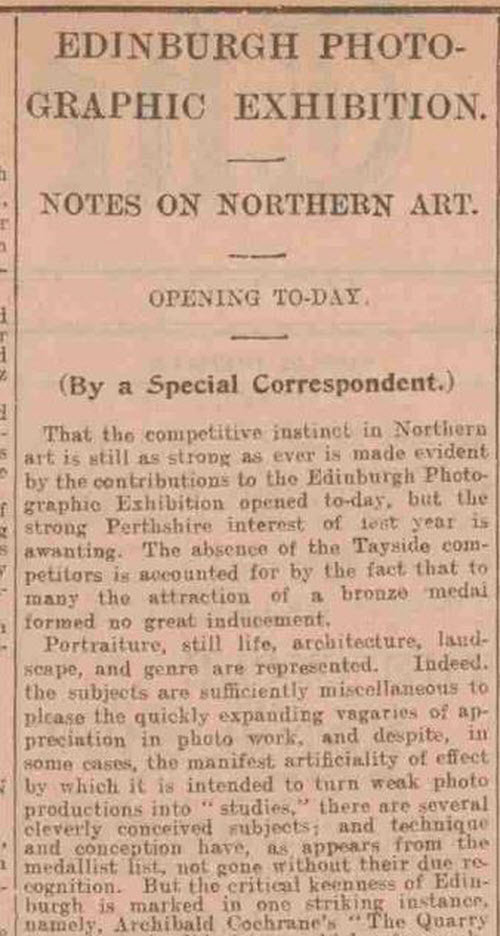
Edinburgh Evening News – Saturday 30 August 1902
Related Photographers
- Frank Pelham Moffat – John Moffat’s eldest son and business partner
- Edward Moffat – Frank Pelham Moffat’s son and John Moffat’s grandson
- Francis Elwell – father in law of John Moffat’s son, Arthur
- James Brown Knott – John Moffat’s brother in law
~~~~~~~~~~~~~~~~~~~~~~~~~~~~~~~~~~~~~~~
John Moffat’s Family
Father Francis Moffat, b.1782
Mother Elizabeth Rankin (Rankine?)
John Moffat
Born 1819, April 26th in Aberdeen, Scotland
Baptised
Married 1 1847 to Ellen Notman
Child 1 1849 Ellen Jane Moffat – d. 1938
Married 2 1851 to Sophia Maria Knott, b.1820 in Aberdeen, Scotland
Child 1 1854 Frank Pelham Moffat – d. 1912
Child 2 1856 Sophia Elizabeth Moffat – d. 1930s
Child 3 1857 Fred (John F) Moffat
Child 4 1859 Kate Rankin Moffat – d. 1954, May 18th.
Child 5 1861 Arthur Elwell Moffat – d. 1943
Child 6 1863 Alfred Edward Moffat – d. 1950s
Child 7 1866 Alice May Moffat
Died 1894, March 5th
~~~~~~~~~~~~~~~~~~~~~~~~~~~~~~~~~~~~~~~
Compiled by Ron Cosens © 2013 www.cartedevisite.co.uk
Sources
- Sandy Barrie for trade directory information
- Marcel Safier for census details and other additional research
- Ron Cosens for images from the Victorian Image Collection
- David Hooper – a Moffat enthusiast, retired dealer in cdv and source of some of the images used in compiling this biography
- Allan Collier – for historic newspaper reports allancollier17@btinternet.com
~~~~~~~~~~~~~~~~~~~~~~~~~~~~~~~~~~~~~~~
John Moffat – Gallery of mount designs
This gallery contains the MAIN types of photographic mount used by John Moffat’s business.
Reference numbers relate to those devised by the Victorian Image Collection.
Dated photographs by John Moffat are always sought – either originals or scanned copies. If you can help in this regard please contact us. Thanks.
|
|
|
John Moffat mount type 100 – carte de visite – blind stamped
|
|
|
John Moffat mount type 110 – carte de visite
|
|
|
John Moffat mount type 120 – carte de visite
|
|
|
John Moffat mount type 130 – carte de visite
|
|
|
John Moffat mount type 140 – carte de visite
|
|
|
John Moffat mount type 150 – carte de visite
|
|
|
John Moffat mount type 160 – carte de visite
|
|
|
John Moffat mount type 170 – carte de visite
|
|
|
John Moffat mount type 180 – carte de visite
|
|
|
John Moffat mount type 190 – carte de visite
|
|
|
John Moffat mount type 200 – carte de visite
|
|
|
John Moffat mount type 210 – carte de visite
|
|
|
John Moffat mount type 220 – carte de visite
|
|
|
John Moffat mount type 230 – carte de visite
|
|
|
John Moffat mount type 233 – carte de visite – gold edge
|
|
|
John Moffat mount type 240 – carte de visite
|
|
|
John Moffat mount type 250 – carte de visite
|
|
|
John Moffat mount type 260 – carte de visite
|
|
|
John Moffat mount type 270 – carte de visite
|
|
|
John Moffat mount type 280 – carte de visite
|
|
|
John Moffat mount type 290 – carte de visite
|
|
|
John Moffat mount type 300 – carte de visite
|
|
|
John Moffat mount type 305 – carte de visite
|
|
|
John Moffat mount type 310 – carte de visite
|
|
|
John Moffat mount type 312 – cabinet card
|
|
|
John Moffat mount type 314 – cabinet card
|
|
|
John Moffat mount type 320 – chromotype carte de visite
|
|
|
John Moffat mount type 330 – carte de visite
|
|
|
John Moffat mount type 332 – cabinet card
|
|
|
John Moffat mount type 335 – carte de visite
|
|
|
John Moffat mount type 340 – carte de visite
|
|
|
John Moffat mount type 346 – cabinet card
|
|
|
John Moffat mount type 350 – cabinet card
|
|
|
John Moffat mount type 360 – carte de visite
|
|
|
John Moffat mount type 370 – carte de visite
|
|
|
John Moffat mount type 375 – cabinet card
|
|
|
John Moffat mount type 376 – cabinet card
|
|
|
John Moffat mount type 385 – carte de visite
|
|
|
John Moffat mount type 390 – carte de visite
|
|
|
John Moffat mount type 395 – cabinet card
|
|
|
John Moffat mount type 400 – carte de visite
|
|
|
John Moffat mount type 404 – cabinet card
|
|
|
John Moffat mount type 406 – cabinet card
|
|
|
John Moffat mount type 410 – cabinet card
|
|
|
John Moffat mount type 414 -cabinet card
|
|
|
John Moffat mount type 418 – cabinet card
|
|
|
John Moffat mount type 420 – carte de visite
|
|
|
John Moffat mount type 430 – carte de visite
|
|
|
John Moffat mount type 440 – carte de visite
|
|
|
John Moffat mount type 450 – carte de visite
A list of ALL of the known designs is included at the end of this biography.
John Moffat – Gallery of commercial photographs
Examples are shown below of John Moffat’s photographs which were mass produced specifically for sale to the general public.
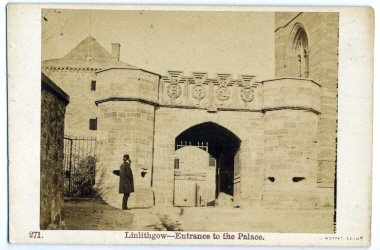
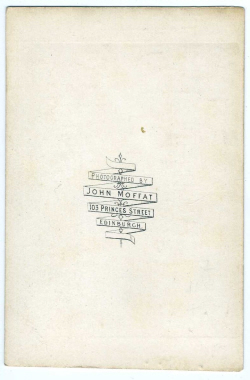
John Moffat – topographical view of Linlithgow Palace on an early Moffat mount
|
|
|
John Moffat – portrait of Reverend & Mrs Spurgeon
|
|
|
John Moffat – portrait of Professor Blackie
|
|
|
John Moffat – portrait of Reverend Buckman
|
|
|
John Moffat – portrait of Dr. Alexander sold by W Weddell
|
|
|
John Moffat – portrait of Reverend Candlish sold by E Bremner
|
|
|
John Moffat – portrait of a local celebrity sold by Peter Pollock
|
|
|
John Moffat – portrait of Reverend Nicholson sold by W Weddell
|
|
|
John Moffat – portrait of a local celebrity sold by Paton & Sons
|
|
|
John Moffat – portrait of Dr. John Brown sold by W Weddell
|
|
|
John Moffat – portrait on a special mount sold by Hugh Paton & Sons
John Moffat – Slide show
Here are 56 examples of John Moffat’s images from the Victorian Image Collection which have not been previously published elsewhere.
Click an image to allow manually moving forward or backward through them.
John Moffat mount designs – with reference numbers allocated by the Victorian Image Collection
|
Code |
Type |
John Moffat mount designs |
|
100 |
cdv |
Blank back & blind stamp |
|
120 |
cdv |
From Life |
|
125 |
cdv |
From Life |
|
110 |
cdv |
Photographer by |
|
130 |
cdv |
Ribbon |
|
140 |
cdv |
Blank back – printed front |
|
145 |
cdv |
Blank back – printed front |
|
150 |
cdv |
Three ladies |
|
160 |
cdv |
M monogram |
|
165 |
cdv |
M monogram |
|
176 |
cdv |
JM – small J – red front |
|
178 |
cdv |
JM – small J – black front |
|
170 |
cdv |
JM – big J – red front |
|
172 |
cdv |
JM – big J – black front – big |
|
174 |
cdv |
JM – big J – black front – small |
|
180 |
cdv |
JM – big J – black front – copies |
|
182 |
cdv |
JM – big J – red front – copies – 30mm gap – printed low |
|
184 |
cdv |
JM – big J – red front – copies -shiny back |
|
186 |
cdv |
JM – big J – red front – copies – 30mm gap – printed high |
|
188 |
cdv |
JM – big J – red front – copies – 38mm gap |
|
190 |
cdv |
Star |
|
200 |
cdv |
Belt – no.103 – brown back – red front – big gap |
|
205 |
cdv |
Belt – no.103 – brown back – red front – small gap |
|
210 |
cdv |
Belt – no.103 – yellow back – no front – small gap |
|
213 |
cdv |
Belt – no.103 – brown back – no front – small gap |
|
215 |
cdv |
Belt – no.103 – brown back – no front – medium gap |
|
218 |
cdv |
Belt – no.103 – brown back – no front – big gap |
|
220 |
cdv |
Belt & border – no. 103 – 1 line text on back, low – horizontal signature – 18mm gap signature to text |
|
223 |
cdv |
Belt & border – no. 103 – 1 line text on back, low – horizontal signature – 15mm gap signature to text |
|
227 |
cdv |
Belt & border – no. 103 – 1 line text on back, low – horizontal signature – 17mm gap signature to text |
|
230 |
cdv |
Belt & border – no. 103 – 1 line text on back, low – slanting signature |
|
233 |
cdv |
Belt & border – no. 103 – 1 line text on back, high – slanting signature – gold edge |
|
236 |
cdv |
Belt & border – no. 103 – 1 line text on back, high – slanting signature |
|
240 |
cdv |
Belt & border – no. 103 & 125 – 1 line text on back, high – slanting signature |
|
250 |
cdv |
Belt & border – no. 103 & 125 – 1 line text on back, high – slanting signature – Established 1853 – yellow |
|
260 |
cdv |
Belt & border – no. 103 & 125 – 4 lines text on back – horizontal signature – Established 1853 |
|
270 |
cdv |
Belt & border – no. 103 & 125 – 4 lines text on back – slanting signature – Established 1853 – yellow |
|
275 |
cdv |
Belt & border – no. 103 & 125 – 4 lines text on back – slanting signature – Established 1853 – brown |
|
280 |
cdv |
Fancy border |
|
290 |
cdv |
Medal – 1 – floral |
|
300 |
cdv |
Signature & copies – no. 103 & 125 |
|
305 |
cdv |
Signature & copies – no. 125 |
|
310 |
cdv |
Medal – 1 – big – no. 103 & 125 |
|
312 |
cab |
Medal – 1 – big – no. 103 & 125 |
|
314 |
cdv |
Medal – 1 – big – no. 125 – no front border |
|
316 |
cdv |
Medal – 1 – big – no. 125 – front border |
|
320 |
cdv |
Chromotype |
|
330 |
cdv |
Medal – 1 – Marion |
|
332 |
cab |
Medal – 1 – Oborne – back border |
|
334 |
cab |
Medal – 1 – Oborne – back border & front border |
|
335 |
cdv |
Medal – 1 – Oborne – various vertical positions on the mount |
|
340 |
cdv |
Medal – 2 – brown |
|
342 |
cdv |
Medal – 2 – maroon |
|
345 |
cdv |
Medal – 2 – copyright |
|
346 |
cab |
Medal – 2 – copyright – back border – Reeves & Hoare |
|
347 |
cdv |
Medal – 2 – Oborne |
|
350 |
cdv |
Medal – 3 – 2 over 4 |
|
360 |
cdv |
Medal – 3 – triangle – copyright |
|
370 |
cdv |
Medal – 3 – oval |
|
372 |
cdv |
Medal – 3 – oval – Reeves – brown |
|
374 |
cdv |
Medal – 3 – oval – Reeves – red |
|
375 |
cab |
Medal – 3 – oval – Reeves – red – back border |
|
376 |
cdv |
Medal – 3 – oval – Mason – brown |
|
377 |
cab |
Medal – 3 – oval – Mason – brown – back border |
|
378 |
cdv |
Medal – 3 – oval – Mason – red |
|
379 |
cdv |
Medal – 3 – oval – Mason – copy |
|
380 |
cdv |
Medal – 4 + star – Weiss |
|
385 |
cdv |
Medal – 4 + star |
|
390 |
cdv & cab |
Medal – 7 + star |
|
395 |
cab |
Medal – 7 + star – impressed on front |
|
400 |
cdv |
Medal – 8 + star |
|
404 |
cab |
Medal – 8 + star + Cadett prize 1895 – white print on front |
|
406 |
cab |
Medal – 8 + star + Cadett prize 1895 – red monogram on front |
|
410 |
cdv |
Medal – 10 + star |
|
414 |
cab |
Medal – 10 + star – white design on front |
|
418 |
cab |
Medal – 10 + star – gold design on front |
|
420 |
cdv |
Blank back – buff – gold front |
|
425 |
cab |
Blank back – buff – gold front |
|
430 |
cdv |
Blank back – green – gold front |
|
435 |
cab |
Blank back – green – gold front |
|
440 |
cdv |
Blank back – green – gold front – Moffat underlined |
|
450 |
cdv |
Blank back – green – gold front – uppercase on front – truncated address |
|
460 |
cab |
Blank back – green – gold front – uppercase on front – full address |
© Ron Cosens 2013 Victorian Image Collection

